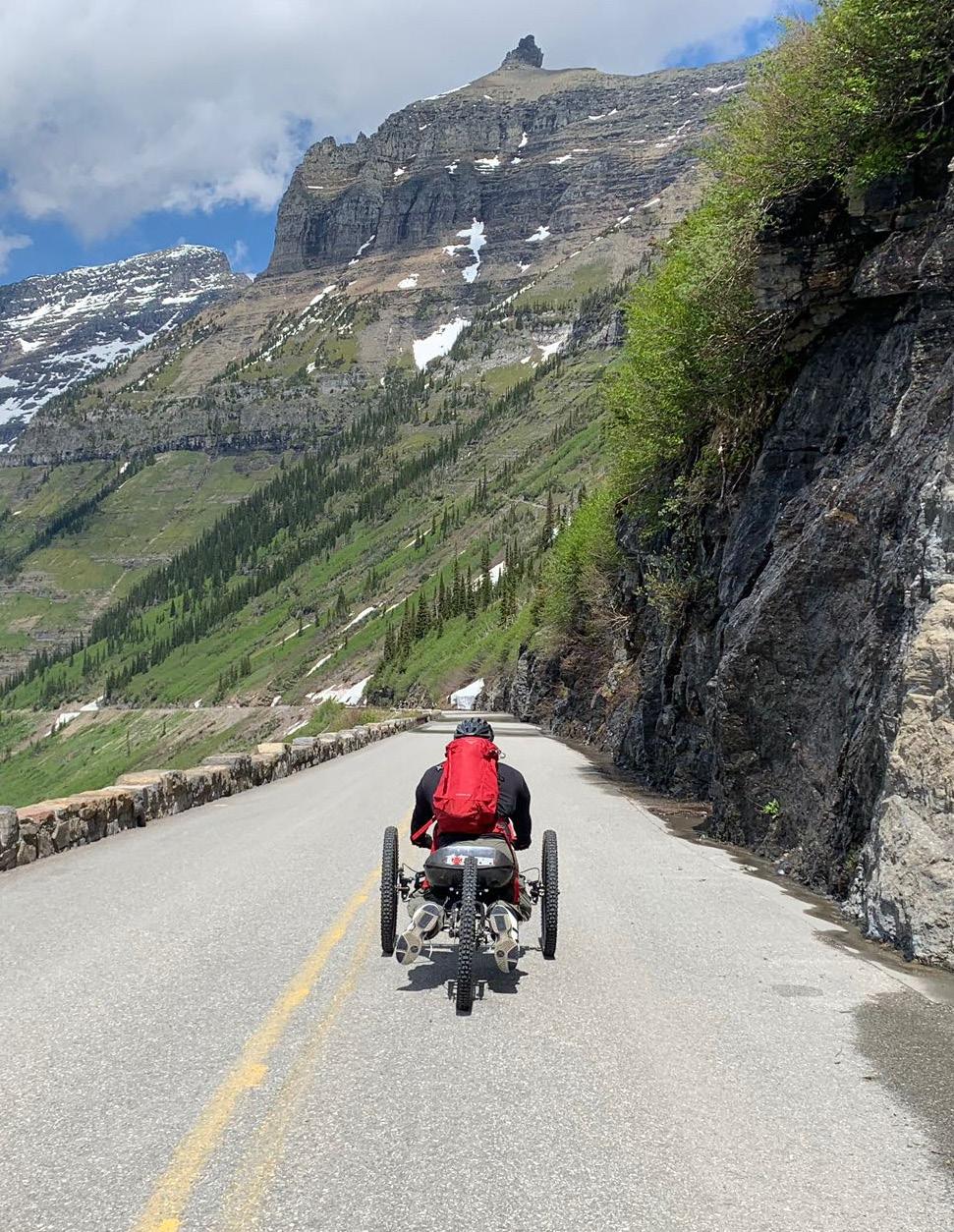Volume 32, Spring 2024


Continental Divide Trail Coalition



Also in this issue: ECHOES FROM THE DIVIDE

Volume 32, Spring 2024


Continental Divide Trail Coalition



Also in this issue: ECHOES FROM THE DIVIDE
BRAVING THE CDT
DREAM TO GET OUTSIDE
Plus a new music playlist, a special book feature, and more!


Zack Bumgarner (he/him) GIS Specialist
Dan Carter (he/him) Trail and Lands Conservation Manager
Claire Cutler (she/her) Community Engagement Coordinator
L Fisher (they/them) Director of Trail Programs
Haley Gamertsfelder (she/her) Field Coordinator
Danny Knoll (he/him) Administrative Assistant
Audra Labert (she/her) Communications Manager Passages Editor
Teresa Martinez (she/her/ella) Executive Director
Allie McCurry (she/her) Development Specialist
Michael McDaniel (he/him) Field Coordinator
Lauren Murray (she/her) Director of Development
Liz Schmit (she/they) Community and Outreach Program Manager
Steven Shattuck (he/him) Director of Operations
Cornell “Corey” Torivio (he/him) New Mexico Regional Representative
Kinsey Warnock (she/her) Field Crew Leader
Jordan Williams (he/him) Colorado Regional Representative
Jill Yoder (she/her) Development Manager
Greg Pierce, President
Kathleen Lynch, Vice President
Don Owen, Secretary
Dean Myerson, Treasurer
Jo Pegrum Hazelett
Arthur Foley
Nick Martinez
Kevin Webber
Amy McCormick
Clancy Clark Amiththan Sebarajah
Amy Camp
Mike Ksenyak
Ben Gabriel




Editor
Audra LabertAdvertising Coordinator Allie McCurry
Continental Divide Trail Coalition 710 10th Street, Suite 200 Golden, CO 80401 Tel: (303)996-2759
The Continental Divide Trail Coalition’s mission is to complete, promote, and protect the Continental Divide National Scenic Trail. CDTC is a 501(c)(3) nonprofit organization and donations to CDTC are tax-deductible to the fullest extent allowed by law. To donate, visit our website at www.continentaldividetrail.org.
Continental Divide Trail Passages is published three times a year for the members of the Continental Divide Trail Coalition. You can learn more about becoming a member here. Members are encouraged to submit story ideas and photographs for inclusion in Passages to the editor at communications@continentaldividetrail.org. For more information about advertising, please contact development@continentaldividetrail.org.
Jess Cody Continental Divide Trail CoalitionDear CDTC Friends,
This letter is coming from southern New Mexico, where I am writing from the dining room table at the Trail Days Home Base in Silver City. All of us at CDTC are busily preparing for the 2024 CDT Trail Days happening Earth Day weekend. April is always such an exciting month and time for the trail and the communities along its path, especially here in southern New Mexico where Hachita, Lordsburg, Silver City, and Gila Hot Springs are preparing to welcome hundreds of northbound CDT travelers. It is also when everyone at CDTC gears up, from the operation of the Southern Terminus Shuttle and Field programs to CDT Trail Days, our main annual event. Trail Days returns every third weekend of April, and the event symbolizes the arrival of spring and the opportunity to celebrate Earth Day along the Continental Divide.
This year, we aren’t just celebrating the 9th Trail Days event. We are celebrating ten years of the CDT Southern Terminus Shuttle program, the 10th anniversary of the designation of Silver City as the first CDT Gateway Community, and the designation of Hidalgo County as the latest CDT Gateway Community! We also recognize the generous hospitality the southern New Mexico Communities have provided– and all of the communities along the trail– to CDT travelers over the past ten years. CDTC as a whole is celebrating ten years of friendships that have made our work so special and heartfelt.
These friends showcase the resiliency of the people who call the Continental Divide landscape home and those who have embraced CDTC’s work while adding their own innovative and creative spirit. It is humbling to learn about the efforts that community members have undertaken in their hometowns to ensure that their neighbors have access to healthy food, healthy lifestyles, and nature within and around their communities. I see communities along the CDT boldly seek and find solutions to address the challenges.
From innovative youth corps mapping recreational sites around their towns and youth mural programs telling the stories of community history to the small businesses asking hikers to share their supply lists so they can have the needed items in stock. These businesses serve as welcoming places not just for their regular customers; they are places of respite for the weary CDT travelers carrying their belongings on their backs. After arriving weary, wet, and wind-blown, travelers who meet a friendly face at the local eatery, motel, or grocery store, can find a warm welcome and generosity beyond expectation.

CDTC Executive Director Teresa Martinez (right/center) and CDTC Board Chair Greg Pierce (far right) celebrate the newly tapped Trail Days Haze at Open Space Brewing with brewery owners Alexa Tubbs and Mathew Leef.
Beyond the past ten years, the communities of southern New Mexico along the Continental Divide Trail have been beacons of warmth and kindness and, in all honesty, have made the CDT what it is today. Still, the Continental Divide remains a place of unbridled adventure and demands constant adaptability and perseverance. Those who find their place within the hard and soft of the Divide are rewarded despite the daily demands. Communities leave the light on and stretch out a hand (or a ride) to lift up travelers, sometimes just when they need it most. These are the moments of human kindness that most CDT travelers will remember long after they have taken their last footsteps along the CDT, and memories of the challenges they faced and overcame have faded. The smiles, kind gestures, and lifelong connections made along the trail are remembered the most.
Sitting here in Silver City, I have run into so many familiar faces in every corner of town– in grocery stores, restaurants, and on hiking trails. It reminds me that there is still so much good in this world. There are so many good people, and because of the trail, we can come together and be inspired not just by what we have overcome in our pasts, but we can look forward to in our collective futures. We are all working together to make each others’ journeys a little bit better.
I wish to thank everyone who makes this journey possible and send the biggest thanks to the communities along the CDT who welcome us into their homes and their homelands, and share with us the love of the places they hold dear. They serve as a reminder of what humanity is capable of– the love, compassion, and kindness that we are all capable of– especially when those acts are not just received but reciprocated. From everyone at CDTC, we wish you all a wonderful spring, and as always, I look forward to seeing you all on the trail!

 Teresa Ana Martinez, (she/hers/ella) Executive Director
Teresa Ana Martinez, (she/hers/ella) Executive Director
Continental Divide Trail Coalition


This spring, the Continental Divide Trail Coalition (CDTC) took an important step in service of the Continental Divide landscape with the addition of a Director of Programs position.
L Fisher had already been an important part of Team CDTC since 2021 as the Trail Policy Manager, and they transitioned into the new role beginning in April. As the Director of Trail Programs, L will provide leadership for CDTC programs to grow a diverse trail community across the Continental Divide National Scenic Trail.
L is an educator and community organizer who grew up in rural Indiana. They received dual degrees in Philosophy and Political Science before earning their Masters in Political Science from Indiana University. Before moving out west, they worked on campaigns and in policy advocacy throughout the Midwest and parts of Texas. Their passion for environmental justice eventually took them to Montana, where they worked as a conservationist and outdoor educator along the Rocky Mountain Front. When they are not working, L is dedicated to being an avid reader, amateur chef, and hiking enthusiast.
As the organization continues to grow, CDTC is excited to begin a new chapter in the mission to complete, promote, and protect the Continental Divide National Scenic Trail. CDTC is committed to building a strong and diverse trail community, providing up-to-date information to the public, and encouraging conservation and stewardship of the trail, its corridor, and surrounding landscapes.

Do you have a passion for trails and skills related to policy?
CDTC is launching the search for a Trail Policy Specialist. Contact info@continentaldividetrail.org for more information.



 By Eloise “Fun Size” Robbins
By Eloise “Fun Size” Robbins
The Continental Divide watershed spans both North and South America, from Patagonia to Alaska. The Continental Divide National Scenic Trail (CDT) covers 3,100 of these miles (4989 km), from the Mexico-New Mexico border to the Montana-Canada border in Glacier National Park. The Great Divide Trail (GDT) continues from the CDT terminus in Waterton Lakes National Park and follows the divide for another 1095 km (680 miles) along the Alberta-British Columbia border to Kakwa Provincial Park. The trail ends there, but the divide continues, crossing the BC-Yukon Border, and then back into the US, running for thousands of kilometers to finish at the ocean at Cape Prince of Wales in Alaska.
Many trails crisscross the divide on the long journey between Alaska and Patagonia. The CDT and the GDT are two of the longest and most renowned. On paper, they are two entirely different trails: different trail organizations support them, different land managers govern the surrounding areas, and they cross through entirely different countries. However, it’s hard to distinguish them when you stand at the end of the CDT at the US-Canada border and the trail continues north, uninterrupted.
Read the rest of the article on the CDTC blog!

Eloise “Fun Size” Robbins thru-hiked the CDT in 2017 and the GDT in 2021. She’s hiked a few other trails, including the PCT and AT. She plans to thru-hike the GDT again this year.


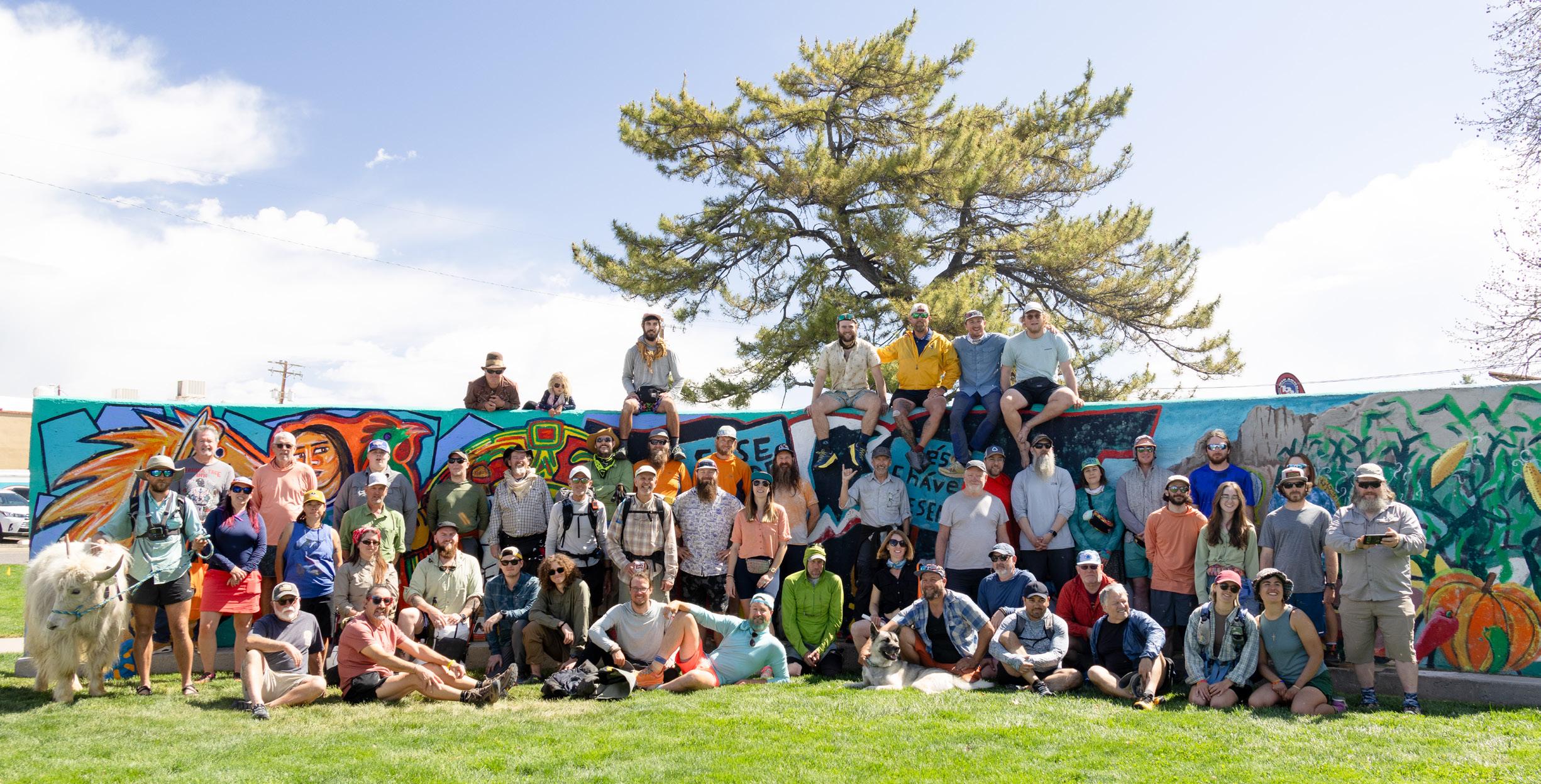
Community members and hikers from near and far met in Silver City for Trail Days this April. The weekend was packed with opportunities to gather and learn, test new gear, and sample community offerings, like the latest Trail Days Haze from Open Space Brewing.
In the words of CDTC Executive Director Teresa Martinez, “If you think this year was great, wait until next year!”
A HUGE thank you to this year’s partners, the community of Silver City, and to all who helped make this year the best yet.

The Indigenous Leaders panel from Friday’s Cultural Landscape Speaker Series (left to right): Mark Thompson: Past Lt. Gov. of the Pueblo of Acoma, Naomi Hartford: Cultural Coordinator, Ft. Sill Apache Tribe, Michael Darrow: Secretary-Treasurer, Ft. Sill Apache Tribe, & Corey Torivio: CDTC NM Regional Rep. and member of the Acoma Pueblo.







Renee Patrick of Intentional Hiking led a fire-side discussion at the Waterworks site.
CDTC staff is honored to host such a powerful event in the CDT’s first Gateway Community: Silver City, New Mexico!

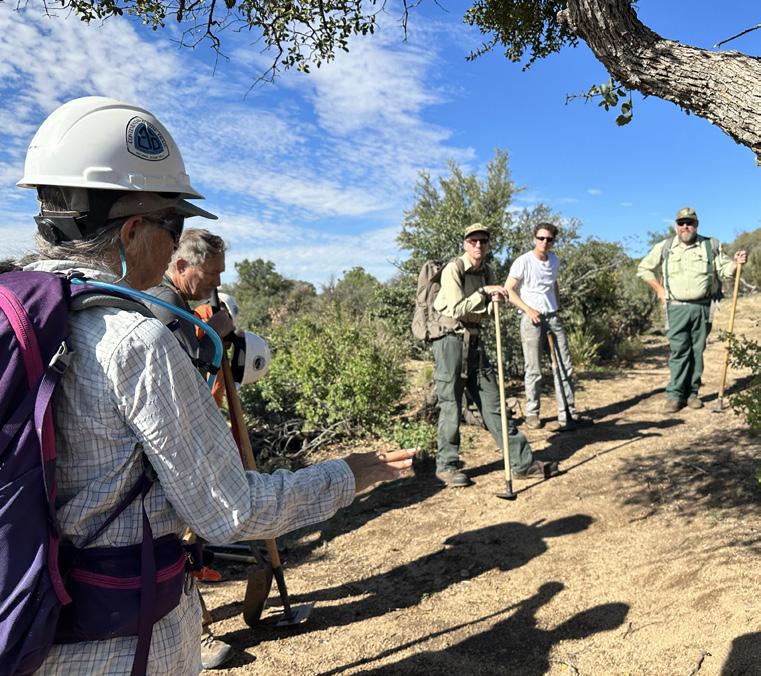
Carol Martin recalls growing up in San Diego, California with the Pacific Crest Trail right in her backyard allowing for a multitude of hiking, camping, and backpacking opportunities.
This instilled a love of long-distance trails for her and her family. When her daughter thru-hiked the Appalachian Trail (AT) years later, Carol was the support person mailing resupply packages along the way. She even got the opportunity to meet her daughter at the top of Mt. Washington and they enjoyed a short portion of the AT together.
When Carol’s husband, Richard, was transferred to Virginia, they both became involved in the Tidewater Appalachian Trail Club (TATC). Maintaining sections through city, county, state, and federal agencies, including the Saint Mary Wilderness in western Virginia.
Carol and Richard now call the Burro mountains west of Silver City, New Mexico home. This is where they have gotten involved with the CDT Coalition since they just so happen to live three miles from the CDT! While attending a CDT ribbon cutting near Silver City, Richard wore a TATC Trail Crew hat. Teresa Martinez (CDTC Executive Director) who is originally from Virginia asked Richard where he had gotten that hat and it turned out they knew several of the same AT maintainers and so the CDT connection was made.



“It’s a beautiful thing and has blossomed over the years.” says Carol. Almost 25 years ago they adopted 28 miles of the CDT north of Jacks Peak in the Burros. In addition they helped Silver City become the first Gateway Community, which will be celebrating its 10th year of designation, this year! Carols says “awareness of the CDT and the benefits it brings to Grant County has inspired more people and businesses to support hikers coming through.”
Since then Carol has been keeping busy maintaining her 3-mile adopted section, promoting the Gateway and Adopter programs, teaching classes on CDT history and sustainable trail maintenance, leading hikes, hosting CDTC Staff & hikers and, as always, being involved in her community. “Giving back is a very satisfying lifestyle.” says Carol, and we agree.
Carol is a wonderful example of our amazing volunteers, and the community the CDT has helped build. Carol hopes for many more years of CDTC stewardship on her adopted section but says “when I age out… there are 2 great neighbors ready to take over the section.” We are so grateful for Carol and all of our amazing volunteers. To come out and build trail and community with us (and Carol!), you can sign up for one of our open projects here

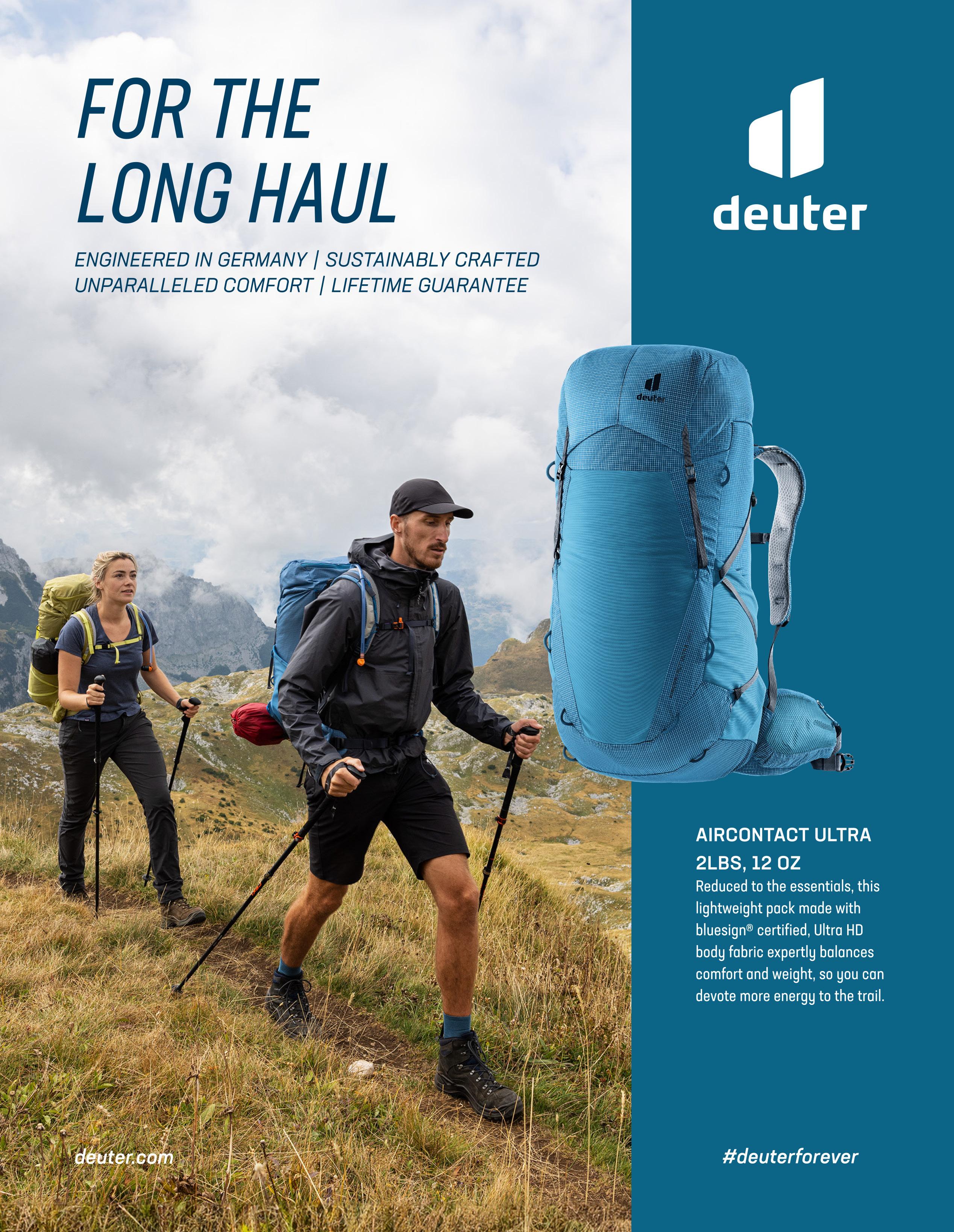

From time immemorial, the region where the boundaries of modern-day southern New Mexico, southern Arizona, and northern Mexico meet has been a convergence point for landscape connectivity, migration, and diffusion for wildlife, water, weather, and humans. Nestled in this hub of activity, the town of Silver City reflects the surrounding ecology and is influenced by a dynamic landscape and converging cultures.
One of the more recent changes in the evolution of Silver City is the designation of the town as the CDT’s first Gateway Community in 2014, which paved the way for other community-led stewardship of the Continental Divide National Scenic Trail (CDT). Silver City has been a collaborative partner in connection with the CDT, a role model for future Gateway Communities, and an innovative space for the intersection of recreation and conservation along the Divide. After a decade of official Gateway Community status, Silver City remains a place where the way of life and the landscape meet is evident from mainstreet to mountaintop.
At 6,142 ft of elevation, Silver City and the surrounding communities in Grant County are amongst one of the most geographically unique and biodiverse
landscapes in the world, on the boundaries between the Chihuahuan Desert and the Sky Islands. The combination of open, arid desert and lush, forested mountains provides an ideal habitat and migratory pathway for plants and wildlife. Over half of the migrating bird species in North America move through the area. The Sky Islands Region also connects the subtropical Sierra Madre of Mexico and the temperate Rocky Mountains of the U.S. and provides a glimpse into the incredible biodiversity– lowland deserts to high-elevation alpine areas– within only a few miles. Community-led groups like the Sky Island Alliance have led the way in educating visitors and locals on the significance of the biodiversity hotspot surrounding Silver City and the importance of protecting those lands and waters for the health and vitality of plants, animals, and humans.
The unique mix of wildlife and plant life has made the region an ideal home for humans throughout history, and it is the ancestral home of many Indigenous people, such as the Fort Sill Chiricahua Warm Spring Apache Nation. Vital water sources like the Gila River and the tributaries in the Great Gila Watershed sustain humans, plants, and wildlife in this landscape. Though it is often misrecognized as inhospitable and empty by outsiders, the area has been thriving with life for generations upon generations.
In the shadow of the Continental Divide, the Gila River is one of the longest rivers in the West and stretches over 500 miles from its headwaters on the Divide toward the Colorado River. The Gila River is one of the last free-flowing rivers in the West, and it provides critical river and riparian habitat for wildlife
such as the Gila River trout, Montezuma quail, Gila woodpecker, Mexican Grey wolf, and the Gila monster. Recent efforts like the Gila Wild and Scenic Campaign, supported by New Mexico Congressional delegation members Senator Martin Heinrich and Representative Gabe Vasquez, recognize the importance of a freeflowing Gila for preserving the health of the landscape and the way of life in Silver City and throughout southwest New Mexico.
Silver City was founded in 1878 and resides on a site that has been home to Hispanic and Anglo settlers for generations and Indigenous people since time immemorial. The landscape holds a complex history, and Western expansion of industry and trade led to rapid growth in the late 1800s and early 1900s. The introduction of the railroad increased opportunities for those moving West, leading to an explosion of mining in the area as well as ranching and agriculture that continues to contribute to the livelihood of Silver City and the surrounding communities of Hurley, Santa Clara, Bayard, and Tyrone.
Many towns across the West that are rooted in traditions of mining, timber, agriculture, and ranching have sought new opportunities. Silver City has led the way in finding a balance between development and natural, open space, and the area is home to the first designated Wilderness in the world. The Gila Wilderness was designated in 1924– predating the Wilderness Act by forty years– and celebrates its 100th year in 2024. Stewards of the Gila Wilderness and locals across southwest New Mexico commemorate this important centennial milestone and envision the next 100 years in the Gila. Silver City, the CDT’s first Gateway Community, also celebrates the tenth anniversary of its designation. These two achievements, though separated by decades, highlight how Silver City remains at the forefront of leadership to preserve these important lands, waters, and trails, and tell the story of where life meets the landscape.
The Continental Divide Trail Coalition (CDTC) was established in 2012, and one of the first priorities was connecting with communities along the CDT. While trail organizations along the Pacific Crest Trail and Appalachian Trail had been working with trail stewards for decades, the model that worked on these sister trails might not be the best fit for the Continental Divide. The landscapes are more varied and rugged on the Divide, and the people are unique in their histories with the land, water, and way of life in the Rocky Mountain West. CDTC leadership believed that the work to shape long-term community support had to be done differently, and it had to be led by the communities who had lived in the landscape for generations.

The year after CDTC was founded, Executive Director and co-founder of CDTC Teresa Martinez received a call from Nancy Cliff, a member of the Silver City Greenways Committee, about the CDTC Gateway Community Program. In October 2013, Teresa traveled to meet with Cliff and members of the Silver City Greenway Committee in Silver City to discuss the possibility of designation. The trip was made in collaboration with Cate Bradley, who at the time was the National Park Service’s Rivers Trails and Conservation Assistance program lead for working with the Greenway Committee. They also visited Hachita, the most southern community in Grant County. Cate and Teresa met with members of the Hachita Community Center Board and discussed the possibility of operating a southern terminus shuttle out of the Hachita Community Center. Those visits were the first of a series of conversations that
“I’m still not 100% sure what being a Gateway Community entails, but when I have welcomed hikers and bikers to our lovely town and the magnificent region where we reside it feels like we are hosting courageous and adventurous newfound family members who are determined and strong and relentless heroes in a sense. Our dream is to be able to continue to assist the CDT travelers with more services and amenities, and to be known as a warm, friendly, loving, and helpful resting point along the trail. We want to be a positive and memorable part of their incredible adventures!”
- Kelly Johnson, Manager at the Murray Ryan Visitor Center
culminated in the designation of Silver City as a CDT Gateway Community the next year. The excitement and enthusiasm from those community leaders marked a significant milestone– one that would transform not just the CDT in the region, but Silver City and the CDTC.
A series of public meetings were held in Silver City in early 2014. Those in attendance at the first public meeting in January 2014 included local leaders from Silver City that CDTC had met with the year before, other community members, staff from Congressional offices like Senator Heinrich’s thenstaffer (now Congressman) Gabe Vasquez, partners like Backcountry Horsemen of America, local Trail Adopters, and the local VFW Chapter who were interested in supporting the 2014 Warrior Expeditions (then Hike) team starting the CDT in April of 2014. All participants were overwhelmingly supportive, highlighting the benefit for local hikers and equestrians seeking opportunities to enjoy and heal in the outdoors, the boost to local business from visitors and thru-travelers, and the continued preservation of the Greater-Gila Region along the Continental Divide.
On April 23, 2014, Silver City, New Mexico became the first Gateway Community of the CDT. The celebration marked the beginning of a new era of community-led stewardship along one of the most world-renowned long-distance trails. The designation also coincided with the launch of a shuttle program for the 2014 season, and the establishment in 2015 of the first CDT office in Silver City in the Murray Ryan Visitor’s Center, a Gateway Community Coordinator Americorps VISTA (with support from the Office of Surface Mining and Reclamation), and the first Trail Days in 2015. CDTC’s Gateway Community program was first conceived to connect with and support communities along the CDT, and Silver City has celebrated this relationship with the trail ever since.
Every year since 2015, CDT Trail Days has marked the beginning of a new season of exploring the CDT. Though some years were virtual, Trail Days has remained a constant and a reminder of the joy of being outdoors in community with one another. The


first Trail Days was hosted in ‘The Big Ditch’, the park along San Vicente Arroyo in downtown Silver City, and had 25 booths with around 250 people in attendance. Since that first year, Trail Days has continued to grow and has moved throughout Silver City, from the parking lot next to Morning Star Sports to the campus of Western New Mexico University, and in most recent years, to Gough Park. The growth of Trail Days has brought a diversity of activities to attract locals and visitors interested in the CDT in all its forms, including a speaker series, a short film festival, breakfast hosted by the Kiwanis Club, and tree cookies handed out by the U.S. Forest Service. Trail Days is a celebration of the breadth and depth of love for the CDT and the outdoors by all who participate.
Since its Gateway Community designation in 2014, the town of Silver City and the surrounding community have been a model for how communities and partners can work together inspired by a love of a landscape. Using the CDT as the roots for this work, Silver City and other Gateway Communities have since demonstrated how the CDT can impact communities in times of transition to explore new benefits from the outdoors, support local livelihoods, and identify renewed value in the connectivity between person and place while sustaining the way of life for those who live in and love the West.
Community members and leaders, partners, CDT travelers, visitors, trail organizations, Tribes and Indigenous people, and others who love the CDT came together in Silver City to celebrate Trail Days and 10th anniversary as a Gateway Community in April. It is important to reflect on the past and envision the shared future of the landscape, the community, and the trail. The first of twenty-one Gateway Communities, Silver City opened the door for an untold number of communities to connect to the CDT and began a legacy of opening hearts and homes to those who love the trail. Much like the legacy of those who choose to explore the CDT, Silver City’s rising to the challenge of being the first is not something that happened alone or overnight. The ability to rise to that challenge happened in community and support–one step after another.
Trail Promotion
CDTC supports communities’ ability to identify needs for communicating information, access points, and planning materials for locals and visitors alike.
CDT Trail Days Trail Days starts in the Big Ditch with 25 partner booths and 250 attendees.
Murals completed by the Youth Mural Project in Downtown Silver City & the Kiosk at the Visitor Center tell the story of the CDT around Silver City.
Silver City tells the evolving story of the CDT through interpretive information, art, and different forms of media for visitors and locals to ensure the CDT experience is enjoyable and accessible to all.
Shuttle Riders
Popularity of the CDT
CDTC Shuttle launched on April 10 and went through May 5, 2024, and hosted 101 passengers.
100- 125 CDT hikers attempt the entire CDT, with hundreds enjoying the CDT for section-, overnight-, and day hikes.
CDT Connectivity 85% Complete
Trail Days attracts thousands of attendees to nearly 100 partner booths and a range of activities.
500+ riders take the shuttle to the CDT Southern Terminus.
Approx. 1000+ CDT hikers and equestrians attempt the entire CDT, with thousands more enjoying the CDT for section-, overnight-, and day hikes
The annual Trail Days celebration becomes a destination for the region, attracting locals and visitors to activities that highlight the breadth of interest in the CDT.
The Southern Terminus is accessible and sustains the impact of the growing number of CDT travelers.
The use of the CDT continues to grow and diversify, welcoming an ever-growing number of first time CDT travelers, new user groups, and even locals exploring the National Scenic Trail in their own backyard.
CDT Signage Signage and information regarding the CDT is minimal and limited to a handful of major trailheads and access points
Gateway Community Ambassadors The Gateway Community Ambassador program did not yet exist.
Trail Stewardship 2 or 3 sections of the trail adopted in Grant County.
96% Complete
CDT Business Member The 1st Small Business Member comes from Silver City!
The CDT is signed in its entirety after the “Blaze the CDT” event in 2018
Cindy Provencio and Simon Sotelo III and become the first two community ambassadors for Silver City in 2018.
The entire section of the CDT around Silver City has been adopted.
The CDT Small Business Program has approx. 30+ members every year across the trail.
The CDT is complete, and connector trails provide access to locals and visitors alike to enjoy the Divide.
CDT kiosks and signage are up-to-date at every road crossing and access point
Silver City Gateway Community Ambassadors grows to include a diversity of local leaders!
Growing community-led stewardship on all CDT sections and connector trails inspires the next generation of CDT stewards.
Dozens of Silver City businesses engage with the CDT to boost the local economy and connect with CDT Travelers!
The Waterworks Site in Silver City, New Mexico, serves as a vital connection point for the Continental Divide Trail and Silver City’s participation in the Gateway Community program . Established in 1887, this site provided the town’s first municipal water supply. Positioned at the intersection of the Gila Wilderness and the desert landscapes of southern New Mexico, this site offers a respite for thru-hikers and visitors, and provides a community gathering space and camaraderie for local residents. In 2020, Southwest New Mexico ACT entered into partnership with Silver City to actively restore the Waterworks Building and the grounds, which are adjacent to Silva Creek. The site also has plans to expand into a cultural interpretive site for local schools to explore the history and culture of the region and participate in community-led sustainability projects.
“The Waterworks Site is a passageway forward, towards the beauty and essence of life ... water and nature for us to appreciate and preserve. [The] generosity and creativity that we’ve seen demonstrated time and time again is very humbling and inspiring.” - Lee Gruber
CDTC collaborates with the Waterworks Site to maintain and promote trail integrity and accessibility, particularly during annual Trail Days events. This project is a vital part of the Gateway Community program and plays an integral role in fostering a sense of community between locals and trail users, ensuring sustainable practices, and providing essential support services. This relationship between the Waterworks Site and the CDT highlights the interconnectedness of outdoor recreation, conservation efforts, and community engagement along the trail, and contributes to the overall success and preservation of the trail through adjacent towns.



A driving force behind Silver City’s Gateway Community designation
“Still waters run deep. Working with Nancy was awesome. She was a tour de force. When she walked into a room she owned it. I had the pleasure of taking part in a few of her many community projects, from initiating restoration work at the Old Waterworks Building, and what has become the Silva Creek Botanical Gardens to CDT Gateway Community status for Silver City NM. Nancy was a trailblazer. Still is.”


The 2022 Black Fire burned most of the Aldo Leopold Wilderness on the Gila National Forest. 300 miles of trails were impacted by the fire directly or from subsequent flooding, debris, and blowdowns. This includes 49 miles of the Continental Divide National Scenic Trail, of which, 23 miles are in a high severity burn area. The Gila National Forest staff have made expeditious progress on addressing the recovery efforts for trails and other public land resources like roads, range infrastructure, and watershed health. To address the trails the USFS coordinated with partners, including CDTC, to complete a post wildfire condition assessment of the trails.
Simultaneously, USFS staff made use of other resources– including trail crews from other regions–to begin logging out trails to improve access for recovery efforts: surveys, staging materials, contractor transportation, and recreation. The recovery effort has brought together a community of partners from conservation groups, volunteers, trail organizations, ranching permittees, agency, and local contractors to pitch in to help this beloved landscape. USFS has executed agreements with partners to expedite the work and engage local contractors and partner organizations whenever possible. Local and regional


organizations such as CDTC, Natural Curiosity, the National Forest Foundation, Sierra Soil and Water Conservation District, and Bat Conservation International have been instrumental to the implementation of the recovery work. Recovery in the Black Range will take many years but with this strong first step, the CDT and other trails will come back even stronger.
CDTC work in the Black Range includes:
• The Trail and Lands Conservation program manager assisted in the development of post wildfire assessment survey and implemented the survey on the CDT
• Coordinating with agency and other partners to address trail maintenance and reconstruction efforts
• Planned Field Operations training on the Black Range to address maintenance needs and build ongoing support in this section of the Trail
• Conveying Trail condition information to the public

The first photo in each set was taken by Whitney LaRuffa and Six Moon Designs team on April 15, 2022. They were some of the last people to backpack through this area before the Black Fire devastated the range one month later.
The second photo in the sets was taken by Dan Carter on March 27, 2023 while conducting post-wildfire surveys on the CDT for the Gila National Forest. The Black Fire was reported on May 13, 2022 and was contained on July 25, 2022.

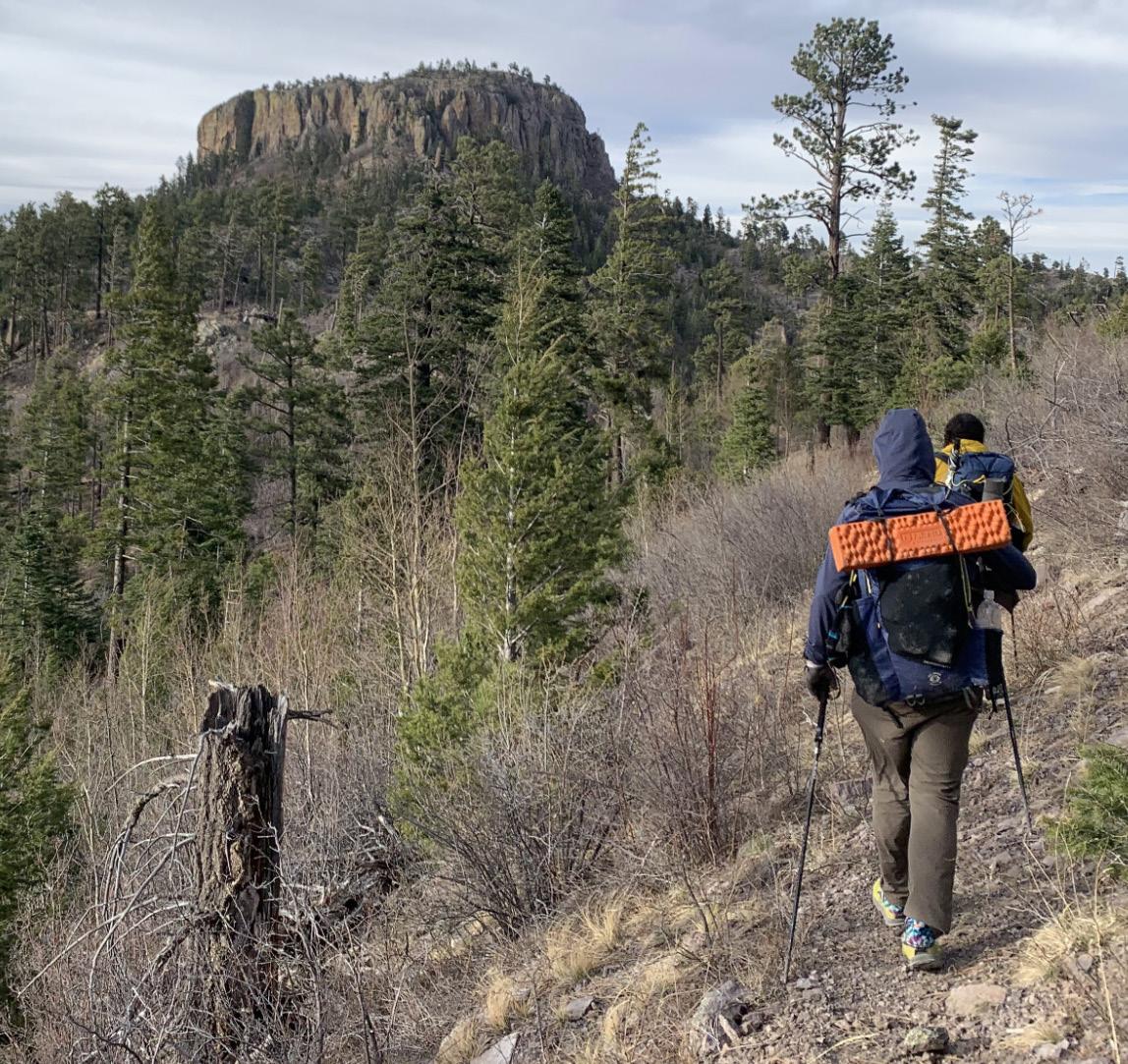

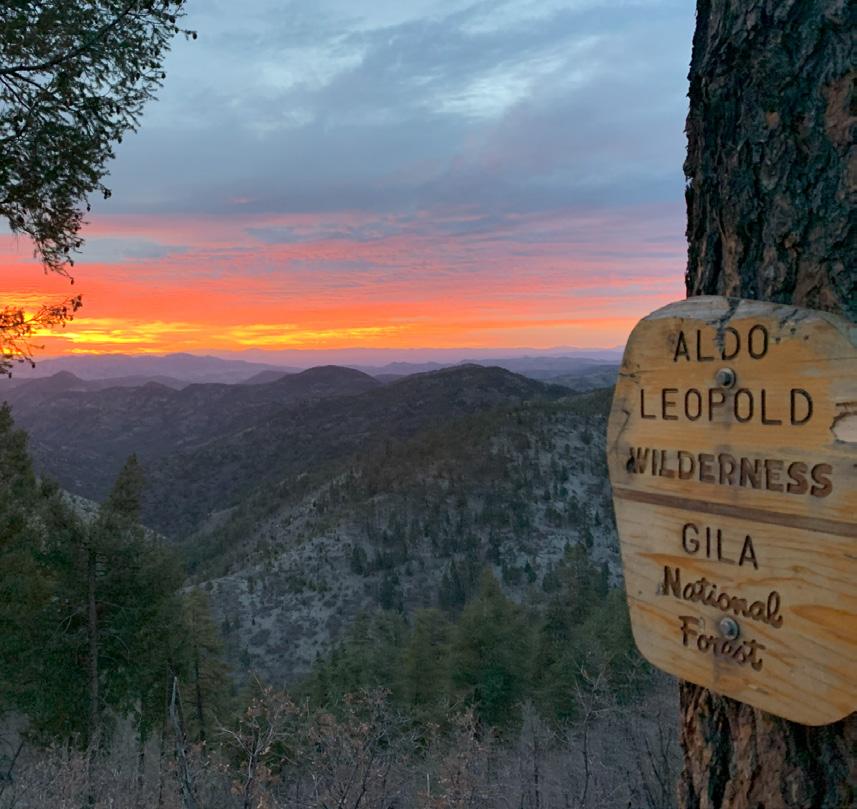

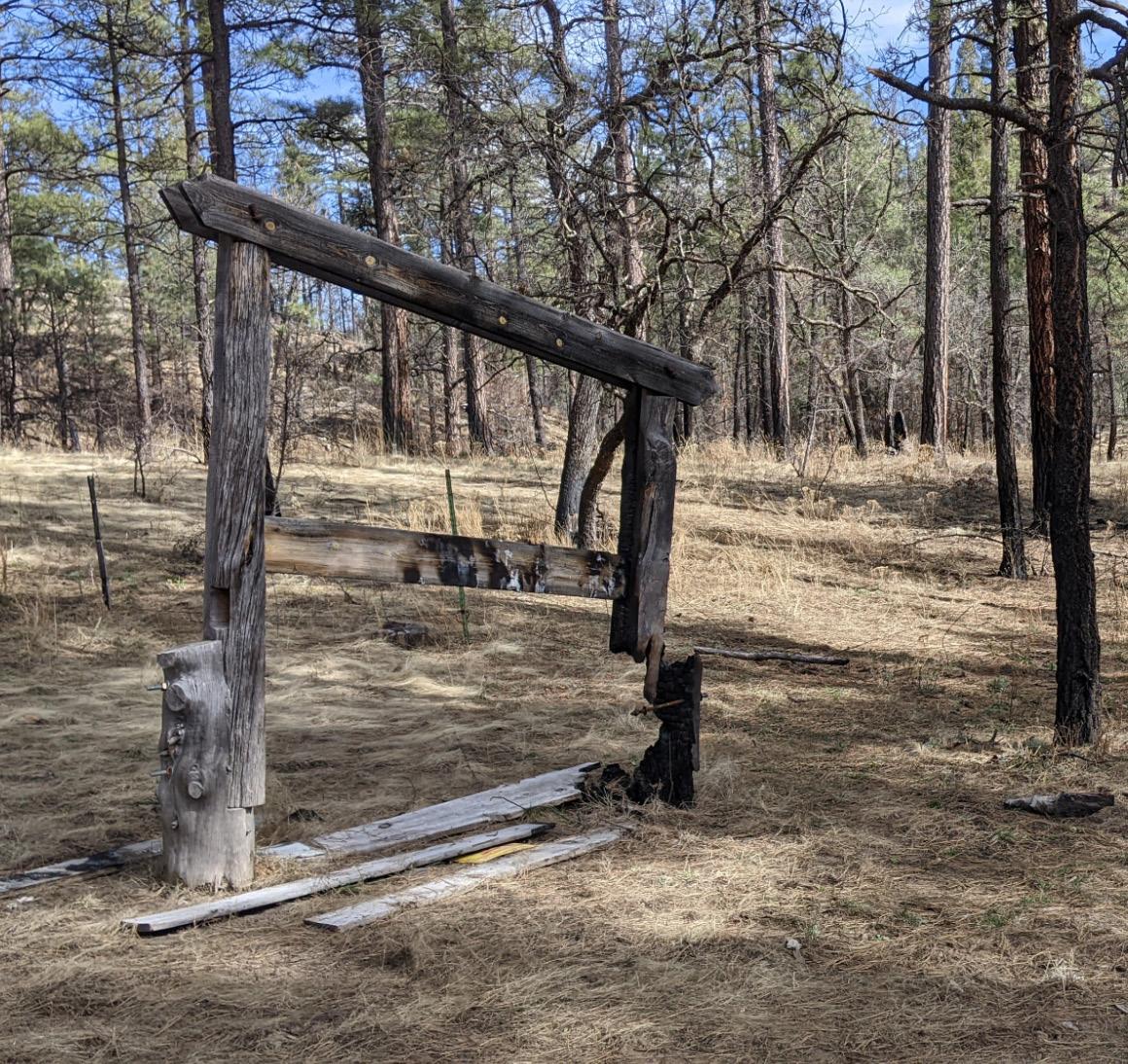


Lured by the allure of America’s legendary trails, my quest for the Triple Crown commenced in 2015 on the Appalachian Trail. It marked the beginning of an extraordinary journey into uncharted realms.
The notion of conquering the trio of iconic trails and the Pacific Crest Trail was barely a flicker in my mind. As I set out on this adventure, I realized it would be more challenging than I had ever imagined. Spanning from the Appalachian to the Pacific Crest and now to the Continental Divide Trail, it was a formidable odyssey.
I found myself engulfed in darkness and grappling with suicidal thoughts shortly before embarking on my hiking treks. I felt utterly lost and thought there was nowhere to turn until fate placed Bill Bryson’s book, A Walk in the Woods, into my hands. Like countless others who found solace within its pages, I wondered if a long walk could illuminate a path toward a life worth living.
Believe it or not, my first-night camping in the wilderness was on the Appalachian Trail! And despite having no prior hiking experience, I embarked on a six-month journey. This journey granted me the will to live, a newfound sense of purpose, and sowed a seed within me.
This seed carried the promise that I would share my own story and create something that would offer others a platform to share their experiences of how wilderness exploration has positively impacted their mental well-being. Knowing that many others grapple with mental health challenges and seek guidance, this platform would be that promise for them. These aspirations laid the foundation for what would later evolve into my nonprofit organization.
By 2023, standing on the verge of completing this ambitious trek, my journey transcended mere miles. During the concluding moments of my Appalachian odyssey, I made a promise to Mother Nature that fueled my journey from the 1,100-mile Florida Trail to the expansive Southwest leading to the CDT. I vowed to share the salvation I found in hiking, giving life to “Hike The Good Hike.”
This commitment inspired 5,000 miles of hiking in 2023, aiming to spotlight our emerging nonprofit and mental health awareness. Walking for the voiceless, I found a more profound purpose beyond personal healing, with the wilderness serving as both refuge and therapist.
My mission to build a community through “Hike The Good Hike” (which is dedicated to mental health advocacy) never wavered while trekking the CDT. The trail underscored the power of shared stories and nature’s healing, providing hope for those facing mental health challenges.
Louise JohnsAmid the breathtaking beauty of glacial lakes, high alpine passes, and the majestic Rockies, the camaraderie with fellow hikers became invaluable. These connections forged in the heart of nature sparked a sense of community, reminding me of our shared journey’s purpose.
In this grandeur, the essence of my discoveries transcended natural wonders, highlighting the profound impact of companionship. Together, we navigated life’s narratives against a wilderness backdrop, weaving a resilient tapestry of mental health recovery.
During my thru-hike, I encountered a grizzled hiker named Shady—named for his remarkable knack for finding shade on the trail no matter the conditions. We quickly bonded due to our experience in life and hiking. The trail was a chance for us both to redefine our lives amidst nature’s beauty. By walking together, we balanced our similarities and differences and formed a dynamic duo with unique perspectives on our journey.
On our second day, Shady recounted an unforgettable moment from years back in San Diego. Initially intending to surf, an impulse led him to run, bringing him near a bridge where he encountered a soul teetering on the edge of despair. Shady intervened without hesitation; his earnest words convinced the stranger that life held more chapters. The man desperately sought a sign to hold onto life, finding it in Shady.
While the aftermath with the authorities remained uncertain, Shady was profoundly moved. He knew he had been the crucial difference between life and departure for that young man. This pivotal moment planted a seed within Shady—a profound realization of nature’s role as a sanctuary and an essential lookout for his mental well-being.

As our adventure together waned, with Mexico still on the horizon, Shady and I dwelled on the profound connection we’d nurtured. The unpredictability of life mirrored the untamed wilderness, yet it was through our intertwined stories that we drew strength. The trail gave us invaluable lessons, teaching us to find meaning in each step despite the hurdles.
This expedition didn’t just enhance my abilities as a hiker; it gifted me a friend for life. Our bond, meticulously woven on the trail, underscored that experiences are indeed life’s most eloquent mentors. My journey with Shady, imbued with collective insights and shared endeavors, profoundly touched my soul, leaving an indelible mark that continuously shapes my path.
Caught in a freezing rainstorm just days from Wyoming, I was engulfed in a perilous chill unlike any I had faced on the trail before. The relentless downpour threatened to freeze me to my core. Recognizing the imminent danger, I made for a nearby dirt road (a potential path to safety). Though daunted by the idea of trekking about 5 miles in such conditions, the hope of finding warmth and shelter in a nearby town spurred me forward.
By a stroke of luck, I managed to hitch a ride into town and found refuge in its sole motel. The warmth of a hot shower began to thaw my chilled bones, starkly contrasting the biting cold outside. I ventured to the local diner across the street, craving a slice of ordinary life. I was drawn by the promise of some comfort food and a frosty beverage—simple pleasures after a day battling the elements.
The diner welcomed me with the inviting aroma of sizzling patties that immediately warmed my spirits. Sitting at the bar, I ordered the most substantial burger and a beer to wash it down. Each bite of the juicy burger and sip of beer brought a comforting sense of normalcy and joy—a much-needed reprieve from the trail’s harsh realities.
While savoring this moment, a man beside me asked if I was hiking the Continental Divide Trail. Confirming his guess, I learned he was biking from Alaska to Mexico City, a journey he deemed less crazy than hiking. Caught off guard by his recognition of me as the “Hike the Good Hike guy,” known among followers as the “Boston Mule,” I listened as he shared his story. A military veteran struggling with severe PTSD, he found inspiration in my social media posts to embark on his journey. His admission that my adventures had partly inspired his mission filled me with a profound sense of purpose and connection.
The journey’s onceadventurous spirit became a grueling test. It prompted a deep introspection about my hiking passion and advocacy work, casting me into a sea of self-doubt.


Our conversation revealed the shared spirit of those who seek solace and strength in the wilderness. While he credited me for inspiring him, his courage and determination inspired me to continue promoting the message of hiking the good hike. This unexpected encounter, rich in mutual admiration and understanding, underscored the powerful impact of shared stories and the enduring bonds formed on the path less traveled.
Basking in Salida, Colorado’s warm sunshine, a voice suddenly interrupted my tranquility. A distinctive southern twang called out, “Boston Mule?” Glancing up, I recognized Puddin, a fellow hiker whose spirit I’d come to admire greatly through our social media interactions. This was our first unexpected in-person encounter despite the sense of mutual friendship and the encouragement we’d shared over the year. Our parallel paths finally intersected like the trail gods had conspired for us to meet.
As I embarked on the Continental Divide Trail, with thousands of miles behind me, I was at a crossroads.
The journey’s once-adventurous spirit became a grueling test. It prompted a deep introspection about my hiking passion and advocacy work, casting me into a sea of self-doubt.
Puddin’s timely arrival marked a serendipitous turning point. Our shared path from Salida became more than a coincidence; it reignited a spark within us both. Our dialogue ventured into self-discovery, acknowledging the trail’s challenges and beauty. This experience transcended a mere physical endeavor; it was a quest for meaning and a commitment to “Hike The Good Hike”—it pushed us toward personal enlightenment.
Our journey wove a healing tapestry through meaningful conversations and shared silences, embodying the trail’s unpredictable yet deeply educational nature. Despite our contrasting personalities—my stubbornness against Puddin’s spirited energy—we found a harmonious rhythm, committed to reaching Mexico together. This commitment deepened our connection and underscored our mutual purpose.
Puddin shared her longing for escape from life’s monotony, a sentiment I knew well. Like many we encountered, her story showcased the trail’s capacity for transformation and hope. Her authenticity and relentless pursuit of genuine living have inspired me and many others.
As I reflected on our shared journey, I was overwhelmed with gratitude for the insights gained, the bonds formed, and the sense of community that the wilderness fostered. Puddin’s impact on my journey is a powerful testament to the strength of shared experiences, the importance of vulnerability, and the pursuit of growth. Our time together emphasized the profound influence of personal connections and the collective wisdom found on the trail.
Amid countless miles and moments of doubt, an unexpected thought struck me on the final day of my CDT thru-hike: “It’s over?” Rather than a beacon of return to normalcy, the end presented a challenge to accept its reality. The staggering beauty of the Continental Divide Trail (CDT) and the year’s







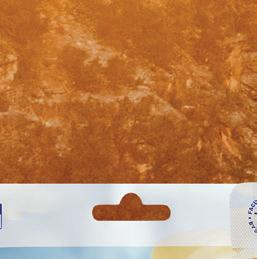
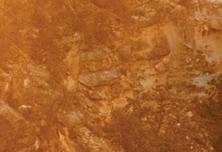
adventures overwhelmed me, yet the connections and the trail’s community resonated deepest. They became my trail family and living embodiments of the stories that had propelled me to Mexico. These magical and transformative encounters laid the foundation for “Hike The Good Hike” (HTGH) to become a tangible community driven by a shared desire to tell our stories.
Our vision is clear as we step into 2024: to cultivate a sanctuary for all who seek solace in nature’s therapeutic embrace during moments when it’s needed most. Inspired by every trail (especially the CDT), “Hike The Good Hike” embodies the promise made atop Katahdin many years ago. Far from concluded, our mission thrives on a collective spirit powered by the wilderness stories that have touched us. Our platform will do more than share my journey; it will give a voice to those who’ve walked their paths.
In the shadow and light of their experiences, we find a universal truth: nature is a beacon for us all.
Hike The Good Hike.









































3796 NM-15, Mimbres, NM 88049
Ancestral land of the Chiricahua Apache
Population: Estimated 30 year-round residents
An hour and a half drive from Silver City, a winding road through the Mimbres Valley leads to Doc Campbell’s Post, a general store located along Highway 15. The Post sits directly on the Gila River Alternate of the Continental Divide Trail, one of the CDT’s most popular alternates taken by roughly 90 percent of all hikers. Doc Campbell’s Post is an essential stop in an otherwise very remote area.
When the Post’s owner and founder Dawson “Doc” Campbell moved to the valley in 1940, the “drive” took about eight hours because there were only wagon roads to follow. The road dead ends farther down at the Gila Cliff Dwellings, though for hikers traveling by foot, the five-mile trip takes closer to two hours.
According to the National Park Service website, “For thousands of years, groups of nomads used the caves above Cliff Dweller Creek as temporary shelter. In the late 1200s, people of the agricultural Mogollon (Southern Ancestral Pueblo) culture made it a home. They built rooms, crafted pottery, and raised children in the cliff dwellings for one or two generations. By approximately 1300, the Mogollon had moved on, leaving the walls behind.”
The Gila Cliff Dwellings were established as a National Monument on November 16, 1907, and it’s largely because of these dwellings that Doc Campbell’s
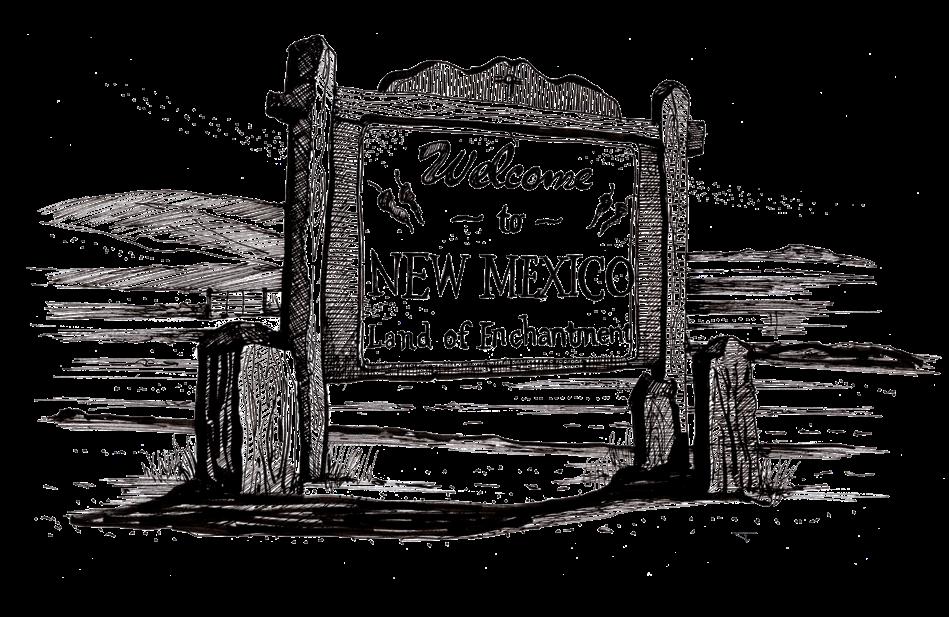
Post even exists. To understand Doc Campbell’s, it’s important to understand the history of the Campbell family, starting with Doc (and no, he wasn’t a doctor, no one knows exactly where the nickname came from).
Campbell moved to New Mexico at the age of seventeen from Pennsylvania, seeking refuge from hay fever. After working for years as a ranch hand, he saved up enough money to purchase the 320-acre Gila Hot Springs Ranch, from which he operated a guiding service to the surrounding ruins.
Although the remoteness of the undeveloped area prevented many from visiting the dwellings, people still found a way, and in 1942 Campbell was appointed nominal custodian of the National Monument, due largely to increased vandalism to the site. In the proceeding years, he worked to document and preserve the area, and in 1955 he was hired as its first seasonal ranger. When construction finally began on Highway 15, the road that would connect Highway 35 to the cliff dwellings, Campbell retired to prepare his business for the expected surge of tourists in 1962. In 1964, he opened Doc Campbell’s Post. The building is heated with water from the nearby hot springs, and cold water comes from the cooling ponds.
“It was open really only during summer months when there was fishing out here and then when there was a jeep group coming through,” said Kristy Lopez, Doc Campbell’s granddaughter. “They mostly sold fishing gear, souvenirs, and the grill—that was it for a while.”
Doc and his wife ran the store for ten years before selling it to Lopez’s aunt and uncle in the 70’s, and they
ran it for the next 45 years. Lopez and her husband, Mike, purchased the establishment in 2018. Lopez, who was born in the valley, moved away when she was eight years old, but returned in 2016 with her three children to work at the store before taking it over.
As a retired Army Veteran, Mike believed in the importance of the outdoors, which became a driving factor in the couple’s decision to buy the business.
“The whole reason we came out here was [because] we have a heart for the outdoors. [Mike] spent most of his military years in special ops. There’s something very healing about the outdoors,” Lopez explained.
“We wanted to lead family retreats that catered to wounded vets, and any time we can encourage anybody to be outside and in nature and to slow down a little bit is what we want to do,” Lopez added.
This year marks 60 years of the Post, and a lot has changed since it opened, and the development of the road led to an increased number of visitors. In 1955, just 711 people toured the site, compared to 24,000 in 1966. Now, roughly 50,000 people annually visit. In addition to CDT hikers, Doc’s is an outpost for jeeps, locals, tourists, snowbirds, car campers, and rafters— all with differing resupply needs, all of which Lopez tries to meet to the best of her ability.
“I remember the hikers coming in and they needed the one-liter Smart water bottles and a couple of other things, but my uncle didn’t want to cater to anybody. He was done, but I started taking notes,” Lopez remembered.
“Before we bought the store, I think there were maybe 40 resupply boxes that came in during the season. They just sat them on the stairs and [hikers] picked them up,” she recalled. During the 2023 season, Lopez reported that they held 375 boxes—not including small envelopes or letters.
According to locals, the Gila River is not safe to cross if it’s more than 200 cubic feet per second (cfs). However, the water levels can fluctuate greatly from week to week, and even day to day.
“[Hikers] will call me in March, wanting to know the water levels for April, but it really depends on the weather. When there’s an El Nino and La Nina, that does make a big difference in our moisture and our river levels,” she said. “It worries me because these same people are planning their hike from blog posts from 2016.”
“If we get a lot of rain in the high country, it will be flooding. We’ve had it in March where it’s 2,700 cfs— that’s major flooding which makes the rafters super happy, but not so good for the hikers.”
During another year, there was a “freak rain” in the spring where the Gila peaked at 1000 cfs for three days straight before it dropped. Two years ago, it

never got high and was crossable the whole year. “That’s what makes it so hard to predict,” said Lopez.
“We always encourage the first [hikers] that hit Pie Town and go through to put details [on FarOut and Facebook] about how the trail and the river levels are,” she said. “[Because] it’s probably not going to be the same as last year, or the one before.”
Hikers should be prepared by researching ahead of time—there’s still no cell coverage in the valley, and although wi-fi can be found in parts, it’s not reliable. Hikers choosing the Gila Alternate should come prepared with patience.
In addition to trying to help hikers plan by monitoring the Gila’s flow, Doc Campbell’s offers a variety of services to hikers. Showers are $5 + tax, laundry is $1.50 to wash and $1.50 to dry per load. Resupply boxes are currently $6 each, but larger boxes are more.
“We have to pay by the pound to dump and haul all [of] our trash, so the box fees offset the cost to dump and maintain the trash trailer and truck used to haul it.” If you choose not to send a box, there’s a selection of hiker-specific foods and supplies available for purchase.
Although Doc’s doesn’t offer overnight camping or a hiker box, hikers can find both of those things at either the Gila Hot Springs Campground or the Gila Hot Springs Ranch.
Whether you stop for an afternoon, a night, or a few, remember the big picture—this is their home, not yours, so treat it with respect. And then treat yourself to some homemade ice cream.
Learn more about the Gila Cliff Dwellings National Monument here.
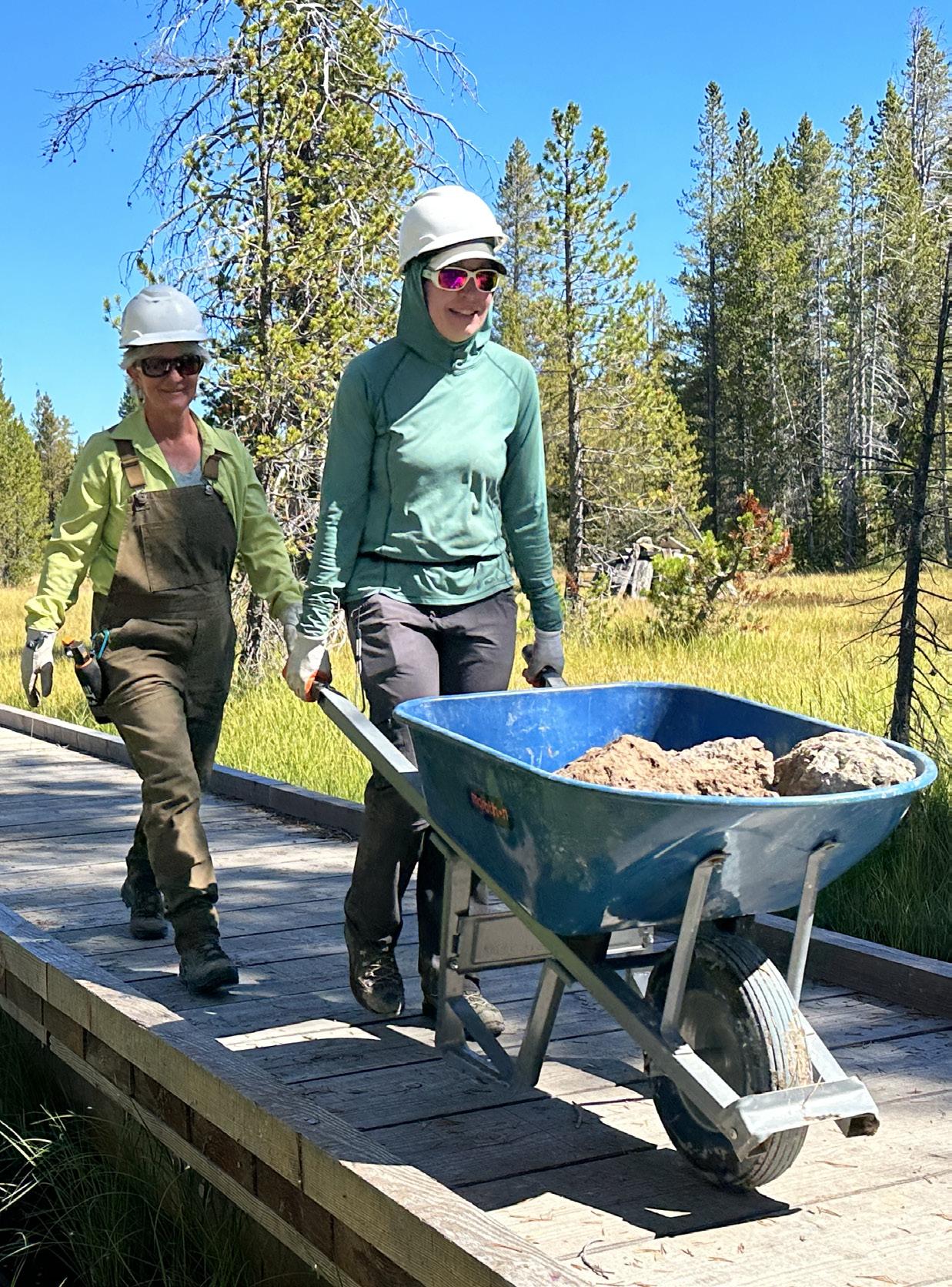




Simon “Odin” Eklov was called to wander the wild from an early age. His latest adventure spanned from Mexico to the Canadian border in 2023 when he set out to thru-hike the Continental Divide National Scenic Trail (CDT). Amidst the awe of the experience, Eklov captured stunning images of the landscape and wildlife. While his photos emanate that feeling of awe, the beauty is not without the beast. The raw challenge and ethereal beauty of the Continental Divide intertwine in an extraordinary experience.
Growing up in Sweden, Eklov– like many others in the country– participated in fast-paced outdoor challenges called orienteering. Picture a crosscountry meet combined with map and compass skills for an image of this activity that originated in Sweden in the late 19th century. Although the pursuit started with military and military-organized competitions, orienteering has gone mainstream in the country with over 75,000 registered practitioners.1
“It’s not very big in the U.S., but it’s basically like running with a map and getting to certain checkpoints in a specific order,” Eklov shared. “I’ve done that since I was ten years old, and I grew up quite active. I’ve always been kind of adventurous.”
From his time as an aspiring child staring at peaks to climb, the desire for adventure grew and eventually led to Eklov’s Pacific Crest Trail hike in 2017 after finishing his education in biology and biotechnology. The five years of “time off” since that first U.S. thru-hike included preparations for another cross-continental hike, and Eklov started the CDT northbound on April 26 and finished on September 18– just under five months.

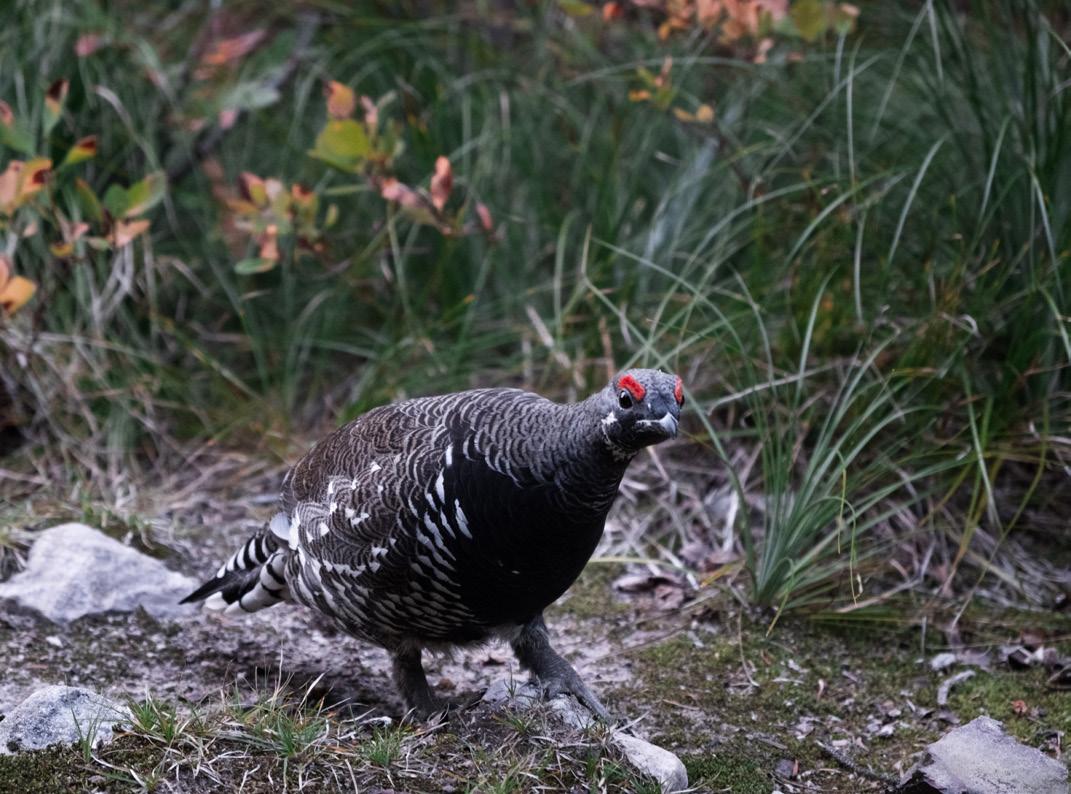
As anyone who has planned a long walk will attest, part of the challenge is the planning. Having at least one long thru-hike on the resume before the CDT can help, and Eklov used some of the insights earned on the PCT on his 2023 hike.
“From my experience on the PCT, I knew that what I had planned before was probably going to come apart,” Ekvlov said with a laugh. “The best thing is to treat it as one day at a time, plan your first stretch as your trip, and then go from there.”
While some have called it ‘brutality’, braving the CDT includes both challenge and choice–a ‘choose your own adventure’ approach. In addition to the official FarOut app ‘red line’, there are official alternate routes (like the Big Sky and Gila Alternates), unofficial routes taken, and the obligatory meanders associated with trail closures, high snow, or other unforeseen obstacles. The redline is considered the route by some, but others– like Eklov– offer a more generous perspective on which trails get hikers to the Terminus.
“Whether you take the shortest route possible, or do the whole thing on the red line, it’s gonna be a big, big challenge,” he said. Eklov emphasized that the trail challenges on multiple levels, regardless of the final mileage. “It’s physically demanding. It’s mentally demanding. You have to tackle so many things.”
Regardless of the challenge, it’s clear that Eklov remained enamored with the beauty of the landscape and the thrill of the unexpected. With an eye for stunning imagery and a lifetime of adventure-seeking, Eklov’s story and photos provide a glimpse into the magic of the Continental Divide landscape–both the rugged and the splendid.

One of my favorite parts on the whole trail was the part just before Cuba [NM], through the mesas–very beautiful. There were just so many places: Colorado is absolutely beautiful- very challenging, but beautiful. I also love The [Great] Basin [WY]; I am a person who loves sunrises and sunsets, and you get some really beautiful sunrises and sunsets [there]. The Wind [River Range, WY] and Yellowstone [National Park] are amazing. I mean, every part of the trail was just super beautiful.
I’ve always been attracted to picking up a camera and taking photos, so that’s how it started. I’ve done a lot of photography and video stuff, so for me, it was a no-brainer to bring my camera on the CDT. The only question was: Would I take my larger camera that gives a little bit better quality, or should I take the old one that I used on the PCT? I decided to take the larger one and carry some extra weight. I think that was definitely worth it. It gives me a little bit more flexibility with the lens, but I really enjoy using the Fujifilm X-T3. For most of the CDT, I used Fujifilm X-T3. Towards the end, I couldn’t use the touchscreen, so I decided to just buy a new camera: A Fujifilm X-H2.










Journeys great and small begin with the right music on the road to the trail. Whether you’re headed out for the day, the weekend, or the season, set the mood for your drive with this playlist compiled from Instagram followers and friends. Happy trails!
If you can’t do this, you can’t do grizzlies.
The thought of hiking the Continental Divide National Scenic Trail (CDT) was terrifying for author Tim Voors. The planning for his 2022 thru-hike started two years before he actually hit the trail, with rigorous mental exercises. From sleeping in a cemetery to grappling with everyday obstacles, Voors prodded himself through uncomfortable situations and some self-imposed challenges with an inner voice that repeated, “If you can’t handle this, you can’t handle the CDT.”
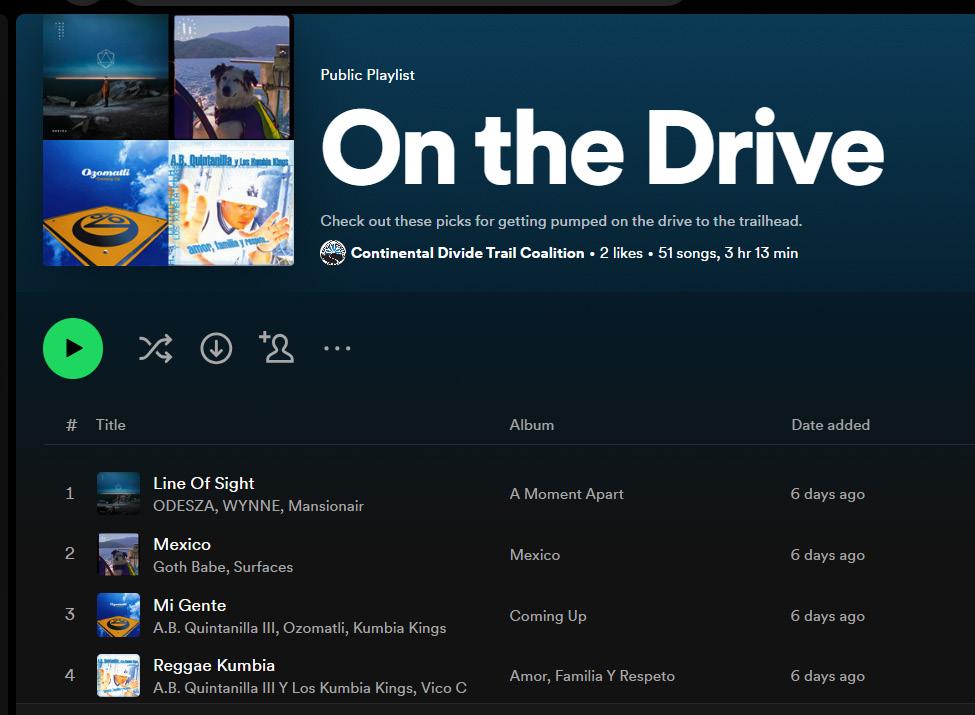
Listen on Spotify


In his new book, The Great Divide, Voors addressed the mental challenges of hiking the CDT and chronicled the many pathways that one experiences during a thru-hike of one of North America’s most remote and rugged long trails. Despite his early reticence, Voors said that he, “Longed for the endless emptiness… America [is] one of the few places where you can really find that.”
The Great Divide reads like a journal, but the story is steeped in stunning photographs and the author’s original art, some of which he created while on the trail. Voors always hikes with art supplies, and his trademark gesture of gratitude along the journey is to gift trail angels and helpful people with a small sketch– earning him the trail name “Van Go.”
Although the author likes to write about what he calls “the rock and roll edge” of being on the trail, Voors is genuinely appreciative of the communities and the people along the way. The book is his way of paying tribute to the trail, giving back to CDT communities, and conveying the richness that anyone can experience in the outdoors. This book will generate excitement for upcoming adventures for the reader or offer a glimpse of the personal depths and expansive landscapes found while hiking the Divide.
Tim Voors lives near Amsterdam with his family. The Great Divide was released in the spring of 2024, and more information can be found on the publisher’s website or where books are sold.


A lot of animals live up and down the Continental Divide Trail. Unscramble the letters of some of our friends to find out who they are and to see their track!
A A E L N J I V
Hint: another name for this animal is the Collard Peccary.


L K E
K A C L B E R A B

W L O F
K I P A
Hint: This small animal who lives on mountaintops looks like a rodent, but is actually part of the rabbit family.

Visit the CDTC website for answers to the activity and more!


In this edition, we asked Instagram followers: Are paper maps still worth carrying, or has digital navigation become the standard?
Here’s what you told us:
44% Yes, paper is my go-to
22% I carry both, paper as a back-up
34% Nope, paper went out like rotary phones

Follow us on Instagram and weigh in on the next Shakedown!

As one of the resident millennials of CDTC, I tend to prefer GPS and phone navigation to paper maps. While I have a stack of paper maps that I frequently consult when planning adventures, I believe too many people have paper maps that don’t actually know how to use them! Triangulation and navigation are a lost art.
Technology has helped us to be more connected to so many things, including the trails and trail communities that we love. Plus you can’t beat the real-time data and tracking that GPS apps offer. In FarOut- having the ability to check when my next water source was in the desert allowed me to camel up and prepare for the dry sections ahead. Getting the most up-to-date restrictions and accurate alternates are also crucial when on a long hike! While I think maps have an important place in the outdoors, I think folks who plan to use them should make sure they know how to use them before fully relying on them. Until then, your phone GPS is an awesome tool :)

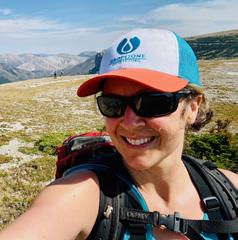 Audra Labert
CDTC Communications Manager
Audra Labert
CDTC Communications Manager
I love the look and feel of paper maps. I still spread them out before and during lunch breaks on hikes to get a lay of the land and study the topography. Paper maps provide more than a little window, and I love how maps encourage people to look up, rather than down. I was paper-only for years, during winter Hawk Owl surveys in Glacier and my Wilderness Ranger days in the Bob Marshall Wilderness. They don’t get low batteries, and they are less likely to be ruined when dropped in water or in the rain.
However, I was recently converted to at least having both a digital map app and my seemingly old-school paper navigation while guiding trips in The Bob. Apps have become so common that when I would pull out a paper map to answer questions, clients would nearly roll their eyes at me! Since paper maps make it a little more difficult to pinpoint the distance to the lunch spot down to the tenth of a mile, people sometimes disregard them. There are, admittedly, a lot of other great features to the apps, and I find myself using them frequently during my travels.
So now I carry both, but if I had to choose one: Paper all the way.
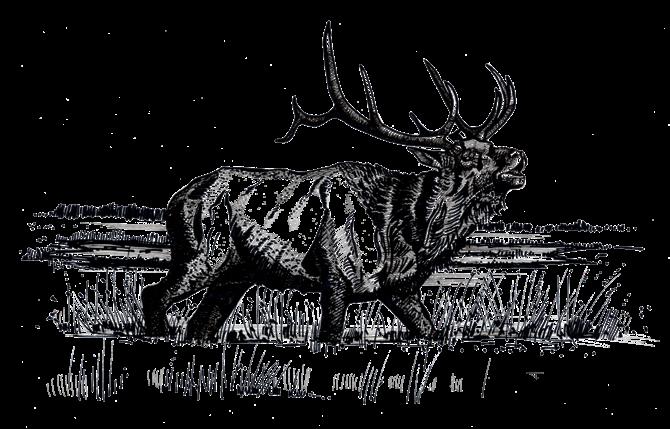 Photo credit Guthrie Alexander
Photo credit Guthrie Alexander
Members are the core of our organization and its efforts to protect the Continental Divide Trail. By being a member, you support the protection of the CDT and our work to build a broad-based community of people who love and support the Trail. Thank you!
CDTC Charter Members helped build the base of support necessary to help launch CDTC’s efforts in 2012. CDTC owes an incredible debt of gratitude to these important supporters.
2013 FB CDT hikers/Lisa Karst
Alex Martinez family
Allen Filson
Arthur and Denise Foley
Avelino Tamayo
Barney and Sandy Mann
Bernard Wolf
Bill and Debra Pollick
Bill Youmans
Bob and Shell Ellinwood
Bob Brewer
Brad Pierson
Brian Fahlstrom
Bruce Prior
Bryan and Sally Martin
Carlos Schomaker
Carolyn Crump
Chris and Sanne Bagby
Chris Burke
Chris McMaster-ULA Equipment
Chris Smith
Christine and Brad Klafehn
Clare Cain
Copper Kettle Brewing
Dana Foulks
Daniel Weber
Dave and Sandy Slowey
David Dolton
David Lattier
Deb Hayes
Dianne Evans
Dick Kozoll
Don and Amy Owen
Don Thompson
Duane Koss
Elisabeth Chaplin
Erin Saver
Frank and Jean Anne Haranzo
Gary Monk
Gary Werner and Melanie Lord
Gene Allen
George Szeremeta
Greg Pierce
Jack Haskel
James Harrold
James Hlavaty
James Sippel
Janie and Randy Moore
Jean Neely
Jeremy Burton
Jerry and Helga Bell
Jerry Brown
Jesse Hill
Jim Boeck and Vivian Wilson
Jim Hansman
Jim O’Brien
John and Lisa Nelson
John Dufour
John Rowland
Josephine Hazelett
Josh and Lisa Shusko
Karen Keller
Kathy Trotter
Kerry Shakarjian
Kevin Burns
Kevin Linebarger
Lawton Grinter and Felicia Hermosilla
Lydia Mahan
Lyndon Berry
Mal Sillars
Mark Bankey
Mark Flagler
Matthew Kaufmann
Michael Tam
Miguel Quinones
Mike Bates
Mike Dawson
Mike Wollmer
Morgan Sommerville
Nancy Huber
Nicolas Martinez
Olivia Holmes
Olli Tam
Pat O’Donnell
Paul Breed
Paul Corbeil
Paul Griffith
Paul Magnanti
Peter Karnowski
Peter Necarsulmer
Philip Storey
Rebecca Louden-Louden Family
Foundation
Rebecca Sudduth and Daniel Weber
Reese Lukei
Rex Alford and Alice Pierson
Richard Ostheimer
Roanoke Appalachian Trail Club
Robert Kristoferitsch
Robert Sylvester
Sara Glasgow
Scott Williams
Shane O’Donnell
Stephen Olson
Steve Staley
Steven Sheppard
Susan Bates
Tambi Gustafson
Taylor and Nancy Owen
Teresa Martinez
Thomas Holz
Tim Hart
Tim Zvada
Vince Auriemma
Whitney LaRuffa
We wish to thank the following individuals for their generous donations between October 15, 2023 -April 1, 2024.
Adam Reichert
Adrian Harrison
Alan Tempel
Albert Ruggles
Alden Short
Alex Kurtz
Alexa Tubbs
Alison Sterley
Allan Slocum
Allmuth Perzel
Amanda Losch
Amy Camp
Andreas Rein
Andreas Renner
ANDREW BIDWELL
Andy Kipp
Anita Ortiz
Anna Flessner
Annette Sanders
Anonymous
Aren Moore
Arthur And Denise Foley
Audrey Ewin
Avery Mackenzie
Bart Martin
Benevity Community
Impact Fund
Bernard Morenz
Bill & Joanna Lasher
Bill Calhoun
Bill Wernsing
Bob Snyder
Brent Ramsby
Brian Meehan
Brian Micheletti
Bruce Leiding
Callie Schieffer
Carly Klemawesch
Carol & Jim Pierce
Catherine Lacrosse
Chad Ferguson
Charles Jackson
Cheryl Brown
Chet Dixon
Christopher Pirrello
Christopher Swann
Clay Bonnyman Evans
Colleen Bauman
Colleen Moore
Cory Godwin
Craig Macpherson
Curtis Savoie
Dave Hale
Dave Scheibel
David & Laurie Root
David & Mary Langford
David Fortune
David Peterman
Deborah Robertson
Diane Gansauer
Dick Blue
Donald Lenc
Donald Siebe
Douglas Prosser
Dustin Johnson
Dwight Aspinwall
E M Geouge
Earl & Karen Philips
Ed Wolcott
Edward Lefferts
Edward Smelko
Elaine Geouge
Elizabeth Glass
Elizabeth Morton
Emilie Kelly
Emma Nagy
Emory Moore
Erin Oliver
Ernesto Fuentes
Gabriel Smith
Gary Berg
Gary Werner
Glenn Knippenberg
Gregg Martin
Gregory Mcdaniel
Heather Jossi
Insa Wood
Jackie Bouker
Jacques Pulce
James Fowler
James Harrison
James Madden
James Wise
James Wise
James Wright
Jana Willsey
Jason Henschen
Jeanie Youngwerth
Jeff Buffo
Jeff Erion
Jeffrey Harker
Jeffrey Robertson
Jennifer Banks
Jerry And Helga Bell
Jillian Ardrey
Jim Dehmlow
Jim Fowler
Joel Kavanagh
John And Sue Pearson
John Hamilton
John Mclarty
John Rooney
John Rowland
John Wieland
Jon & Lisa Bouknight
Jonathan Grief
Joseph Younger
Judy And Rick Babcock
Julia Plews
Karen Murphy
Karl Luce
Karl Schults
Karla Hayes
Karla Wiencek
Katherine Moore
Kelly Nelson
Kenneth Heuer
Kevin Burns
Kevin Landgraver
Kevin Linebarger
Kevin Myers
Kevin Shilling
Kirk Nelson
Kristine Mol
Kyle Jaroszewski
Larry Graham
Lauren Dix
Laurie & Leonard
Adkins
Lawrence Probus
Linda Spaulding
Ludger Bannierink
Lyndon Berry & Jeanne
Younghaus
Lynn Andenoro
Maddie Leonard-Rose
Marianne Skeen
Mark And Barb Risner
Mark Bruening
Mark Honosky
Mark Swanson
Mark Ulsh
Marshall Foley
Martin Cox
Martin Huettl
Mary Davison
Mary Mckinley
Matthew Sinclair
Michael Dilorenzo
Michael Elder
Michael Gay
Michael Sudduth
Mike Krueger
Mike Ksenyak
Mike Mathisen
Nancy Huber
Nathaniel Anderson
Owen Eigenbrot
Pat O’meara And Lynne
Uhring
Paul Tennery
Percy Pentecost
Peter Hsia
Peter Sellstrom
Peter Spindler
Race Owens
Randi Oriani
Ray Klahne
Raymond Brown
Richard Allen
Richard Ashbaugh
Richard Sayre
Richard Virtue
Rick Ostheimer
Robert Broderick
Robert Elliott
Robert Liseno
Robert Maher
Robert Pierson
Robert Spong
Robert T Reeves
Ronald Parry
Russell Fory
Sarah del Puerto
Scott Davis
Sharky Cornell
Shelby Hallmark
Sheri Atkinson
Stephen Bailey
Stephen Engelhardt
Steve Hill
Steve Staley
Steven Meyer
Steven Rich
Stuart Miyake
Susan Green
Susan Janssen
Susan Queary
Ted Hitzroth
Ted Olson
Thomas Gannon
Thomas Weaver
Timothy Mcguire
Tina Tempest
Tracy O’Brien
Travis Chapin
Travis Mattern
Tristan Jones
Vernon & Deborah
Jarboe
Vince Auriemma
Wade Janecek
Wally Wininger
Wayne Sayer
Wendel Hann
Wendy Wicke
William Barns
William Erler
William Henzel
William Lenoch
William Mccalister
William Mcintyre
William Montfort
William Schumann
Wim Schalken
$500-999
Alan Carpenter
Alexander Swann
Amy McCormick-Friesz
Anitra Kass
Anonymous in Honor of
Nicholas Renninger
Christina Osmon
Daniel & Ilene Cohen
DC & Buttons Ward
Ellen Baker
Eric White
George Gresham
James Borden
James Hlavaty
Jay Bush
Jennifer And Zack
Stockbridge
Jim Sells
Margaret Rice
Mark Meloy
Marshall Rutledge
Peter Leven
Rebecca Louden
Rick Lively
Ryan Jordan
Susan Robertson &
Shawn Donley
Thomas Ewing
Thomas Phillips
Wendy Watson
$1000-9999
Aristide Chakeres
Barney And Sandy Mann
Bob Doyle
Caroline Miller
Charles Sweeney
Clancy Clark
Colleen Patrice
Amanda Wheelock
Amiththan Sebarajah
Amy Camp
Amy Mccormick
Andrew Linger
Arthur and Denise Foley
Barbara Nash
Barney And Sandy Mann
Ben Gabriel
Clancy Clark
Dean Myerson
Don & Amy Owen
Emilie Kelly
Greg & Jan Winchester to the Winchester Trailblazer Fund
Greg Pierce
James Hlavaty
James York
Jena Thompson
David Gwinn
Donald Wellmann
Emily McNabb
Evan Gartley
Francis Siracusa
Greg Pierce
James Skelding
Jean Wagner
Josephine Hazelett
Julie And Tim Smith
Karen & Pete Peterson
Kathleen Lynch
Kim Kanas
Kirk Mcwethy
Lon Cooper
Melissa “UV” and Jim
Prager
Mike McClure
Nicolas Martinez
Paypal Vanguard
Charitable Endowment
Robert Schuler
Robert Walker
Roger Carpenter
Steve Schindler
Thomas Frenzel
Timothy O’rourke
Trina Gibbs
Vivian Wilson
William & Minni
Hollingsworth
William Murphy
$10000+
Daniel Collins
Mitchell H. Lasky & Cecilia M. Barajas
Robert J Weggel to The Robert J. Weggel CDT Legacy Fund
Jim Hunter
John Mclarty
Josephine Hazelett
Josh And Lisa Shusko
Kathleen Lynch
Kerry Shakarjian
Linda Spaulding
Matthew Lindelow
Michael Schechtman
Mike Ksenyak
Nicolas Martinez
Paul Magnanti
Randy Welsh
Rich Blitz
Rob Hutchinson
Robert J. Weggel
Steven & Grace
Shattuck
Teresa Martinez
Tom Phillips
CDT Sustainers help us protect the trail all year long by giving monthly donations. Join them by signing up on our website for as little as $5 per month!
Adrian Harrison
Alexander Asai
Amy Aloe
Amy Buchanan
Amy McCormick-Friesz
Andine Gilmore
Anitra Kass
Annette Sanders
Aubrey Renfroe
Barry Reed
Ben Gabriel
Ben Sweeney
Brent Lindon
Brian Deames
Carol & Richard Martin
Cayce Roach
Chad Ferguson
Christina Osmon
Cody Miller
Connie Mahan
David Fockler
David Nowak
David Schlewitz
David Spangler
David Warner
Dayna Fisk Williams
DC & Buttons Ward
Debra Calhoun
Denise Hasskamp
Dennis Solo
Derek Sherry
DiAnna Corden
Donna Siefert
Elaine Geouge
Erik Schultz
Erin & Ed Lucero
Erin Gewuerz
Erin Woodrow
Ernesto Fuentes
Frances Galvin
Gabriel Smith
Garrett Delmas
Gerald Nielsen
Gerald Retzlaff
Heather Farrell
Heather Stabler
Heidi Jones
James Boeck
James Crawford
James Fowler
James Williams
Jason Harley
Jessica Suhowatsky
John Clark-Kuebler
Jonathan Geilhufe
Jonathan Smith
Joni DuPre
Jordan Williams
Karen Loveless
Karen Monsen
Karl Schults
Katherine Moore
Kathleen Johnson
Keith Lippwe
Keith Wagner
Ken Muller
Kyle Svoboda
Lauren Murray
Leslie McCurry
Lisa Cook
Lynn Andenoro
Lynne Krulich
Marjorie Dillon
Mark Mitford
Mark Swanson
Martin Smith
Marty Leake
Mary McNeill
Mary Stoecker
McLean Smith
Melinda Bise
Melissa “UV” and Jim Prager
Merrill Glustrom
Michael Lang
Mike And Tina Dawson
Mike Reynolds
Patrick Foley
Patrick Madison
Paul Tennery
Rachel A. DeHoyos
Rachel Danczyk
Randy Walker
Raymond Brown
Renee Patrick
Rhonda Ronan
Richard Sayre
Robert Boulis
Robert Flynn
Robert Mabry
Robert Romanoff
Robert T Reeves
Roger Carpenter
Ronald Parry
Ryan Harry
Samual Waterman
Sara Bishop
Sarah Estrella
Sarah Gude
Sarah Wustrack
Scott Piddington
Steve Falconer
Steve Moffitt
Steven Meyer
Steven Nesbit
Tawnee Smith
Ted Olson
Teresa Ellis
Tracy Lanktree
Troy Lawson
Wendel Hann
Legacy Members make a lasting impact to protect the CDT for future generations by including CDTC in their will or estate plan. Contact CDTC Director of Development Lauren Murray at lmurray@continentaldividetrail.org if you are interested in becoming a Legacy Member.
Barney and Sandy Mann
Bart Lami
Bill Murphy
Cindy Carpenter
Dick Vogel
Jean Ella
Josephine Hazelett
Thank you to the following CDTC sponsors.
307 Llama
AllTrails
Backpacker’s Pantry
BearVault
Big Agnes
Big Sky Montana
Blackfoot River Brewing
Brent Umphlett
Photography
Buff
Colorado Native Creede Creekside Cabins
Darn Tough
Desesh
Deuter
Enlightened Equipment
ENO
Fairmont Hot Springs
Resort
Farm To Feet
Roger Carpenter
Teresa Martinez
Tom Lefferts
Trevor Twose
Farm to Summit
FarOut
Gila Hike and Bike
Gossamer Gear
HomeLight
Honey Stinger
Hyperlite
Katabatic Gear
La Cumbre Brewing
Last Best Supply Co
LEKI
Melanzana
Monarch at the Crest
Montbell
Morning Star Sports
Mountainsmith
Mustang Inn
National Geographic
Oboz Footwear
One in a Million Vacation
Homes
Open Space Brewing
Osprey
Outside Magazine
Pact
Pintler’s Portal Point6
Readywise
Salida Mountain Sports
Saltwater on the Fly
Sawyer
Seek Dry Goods
Six Moon Designs
Sole
Storm Peak Brewing
Switchback Premier
Adventure Properties
Switchback
The Base Camp
The Golden Mill
The Murray Hotel
The Tent Lab
The Trek
The Village at North Form
TOAKS
Town Shirt Co.
Trail Magik
Trailblend Coffee
Triple Crown Coffee
Twin Lakes General Store
ULA Equipment
Vapur
Wood’s High Mountain
Distillery
Woolrich
Yampa Sandwich Co
YETI
Zapier
Zpacks
THANK YOU TO OUR 2024 PASSAGES SPONSORS!
















Through type II expeditions and unforgiving conditions, the perfectfitting Aether/Ariel Pro overcomes every obstacle. Whether you’re wilderness climbing or winter trekking, custom-fit suspension and strippable features lighten even the most gear-intensive loads— so you can be at your most capable in the backcountry.

Sun on skin, dirt under fingernails, deep breaths of fresh air after a steep climb: It’s a shared experience for people who love to spend time on the trail. And with over 30 million acres of public lands in Montana – including the wild areas that make up the Continental Divide landscape in the state–there’s a lot of space to share.
The outdoors are for everybody. But not everyone has equal access.
According to the CDC , one in four adults in the United States has some type of disability. Yet access to the outdoors for people with disabilities often comes with major barriers: everything from lack of accessible parking at a trailhead to the high cost of equipment.
DREAM Adaptive Recreation is located in Whitefish, Montana, and helps people with disabilities find their way around, over and through some of those challenges.
DREAM runs winter ski programs alongside summer mountain biking and water-based recreation in Northwest Montana’s Flathead Valley. “[Our programs] help people have direct access through us breaking down barriers, from adaptive equipment, adaptive instruction, providing a safe space to try something in the outdoors,” said DREAM Executive Director, Julie Tickle.
This includes reducing the financial cost for participants to use adaptive recreation equipment like sit skis, adaptive paddle boards, electric-assist recumbent bikes, and other gear. The organization served nearly 350 program participants in 2023, according to Tickle.
“All of our programs are centered around each individual. Where do they want to go? Some folks literally want to get back for a hike in nature, and we use one of our adaptive mountain bikes as a tool to hike,” said Tickle. “That could be on a mellow, flat trail or a logging road.”
“But others want to ride the Spencer [Mountain] freeride trails,” she added. The progression depends on the person. “Do they want to go backcountry camping and find a mobility device that they could go for miles and miles, get a backcountry permit in Glacier, and get to a campsite?”
Tickle pointed to Bowhead, a company based in Calgary, as one example of exciting adaptive recreation equipment on the market that can help people with disabilities access some of those backcountry spaces.
With an articulating front end and a full suspension, Bowhead’s fully electric bikes are designed to navigate
rugged terrain. Bikes from Bowhead run upwards of $15,000, according to their website.
DREAM has three of the bikes, one of each model available. Their fleet includes a range of adaptive equipment for people to try out, without the upfront cost of buying their own. And when someone is ready to get their own gear, DREAM can help. The organization itself doesn’t offer funding, but Tickle said, “We’re pretty knowledgeable about helping people figure out what piece of equipment they should try to get and then connecting them with other funding organizations.”
While DREAM’s programming often involves equipment that could be called adaptive mountain bikes, how to describe them depends on where they’re used. “A lot of the adaptive hand cycles or foot pedal recumbent mountain bikes have e-assist, and that is creating equality,” she said.
But as Tickle explained, on non-motorized trails these bikes meet the definition of a wheelchair, permitted under the Americans with Disabilities Act (ADA) and the Architectural Barriers Act (ABA). “When we’re in spaces that might not be biking-friendly, we call them mobility devices because they truly are. People could not access hiking trails without these mobility devices,” she said. That definition also applies to areas like the Bob Marshall Wilderness Complex along the CDT, where mechanized use is typically not allowed.
“When you’re walking around the city streets you might put on one pair of shoes, but if you go on dirt
you might put on your hiking shoes. And for people with disabilities these different mobility devices are like putting on their hiking shoes,” said Tickle.
DREAM has had a hand in expanding access to the outdoors since its start in 1985, and that work continues. “We really revived our access project, and that is going back to our roots,” said Tickle. Those roots include one of DREAM’s early projects, working with the National Park Service on the accessible Trail of the Cedars in Glacier National Park.
Currently, DREAM is involved in several access projects, including a collaboration with Flathead Rivers Alliance to make put-ins and take-outs along the three forks of Montana’s Flathead River more accessible to all users.
According to Tickle, accessibility starts at the trailhead. A lack of accessible parking and restrooms that cannot accommodate a wheelchair are immediate barriers to someone using adaptive equipment to get out on the trail or on the water. Additional physical barriers designed to keep vehicles out, like rocks, berms and gates without room to maneuver around, can make access with mobility devices impossible. “If the trailhead isn’t accessible, then the fun stops right there,” she said.
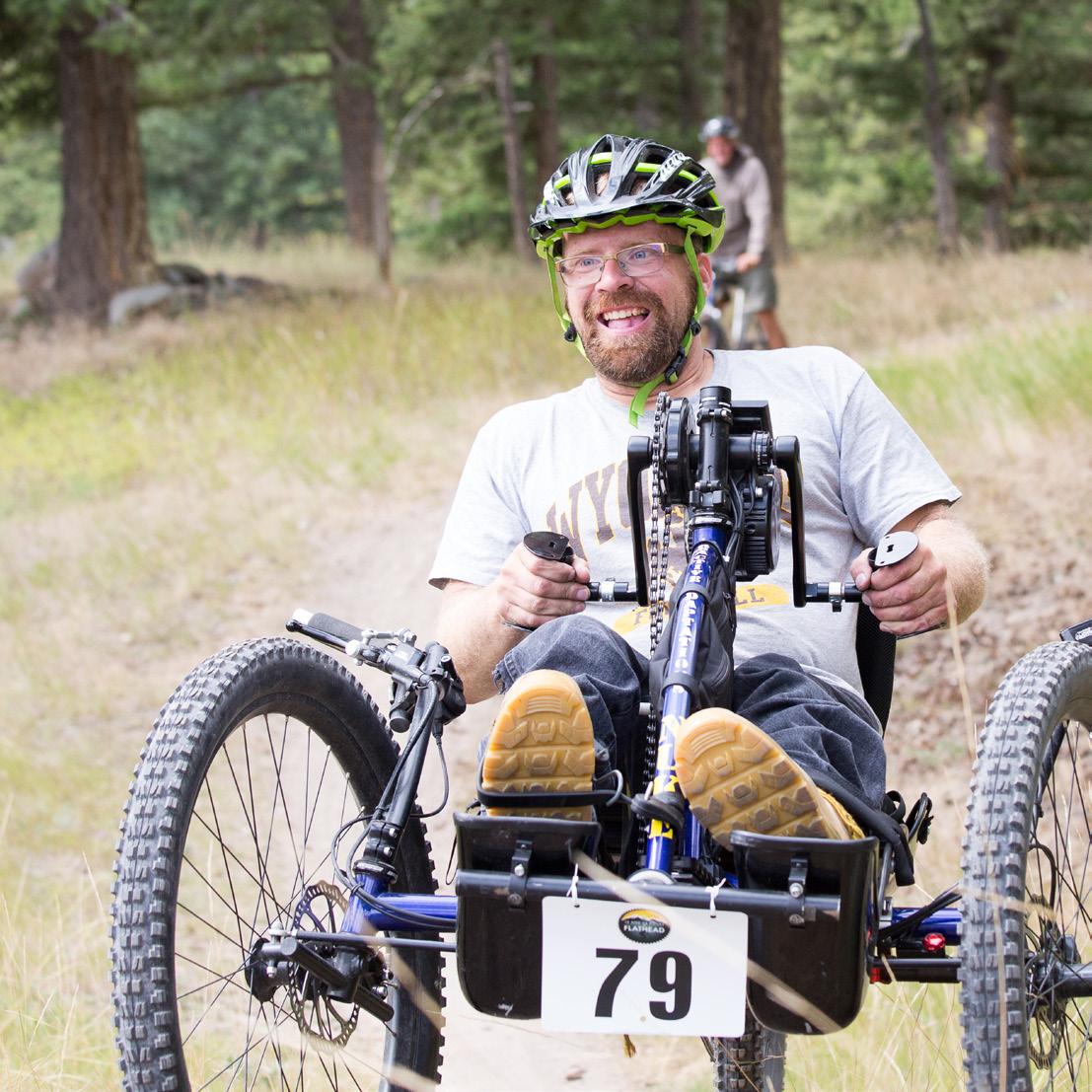

While paved trails meet ADA building standards in developed areas, there are layers to accessibility as trails move away from the frontcountry. According to Tickle, rocks, roots, and other natural trail features don’t necessarily need to be eliminated for someone using adaptive recreation equipment to use a trail. Sometimes it’s about designing a more gradual switchback, removing pinch points where double track decreases to single track, or providing information about maximum grade and cross slope on trail maps.

“It’s a sliding scale of the deeper you go into the natural environment, there are definitely some things that can improve someone using a mobility device’s experience. But it doesn’t necessarily have to be completely sterilized,” said Tickle.
“A lot of people with disabilities have the same goals, hopes, dreams, aspirations, love of adrenaline or adventure…and leaving a lot of that in place is really important, just as it is for those without disabilities,” she said. “Everyone deserves to have the challenge by choice, assessing their own risk and what they want to do.”

Recreation is to enhance the quality of life of individuals with disabilities by providing year-round outdoor adaptive recreational opportunities.



